A meteorite hit Akhnoor area in Jammu, Saturday night following which
many astronomical organizations rushed their teams to study the
phenomenon on the spot.
The meteorite, according to the locals, descended in the open
ground at 11.25 pm. However, it didn't cause any damage to life or
property, owing to its smaller size and low velocity, the locals added.
Many astronomical organizations including Indian Space Research
Organization, TATA Institute of Research and the Kashmir University
dispatched their teams to the area.
One of the experts, who was on the spot, told Greater Kashmir
over the phone, "The meteorite was not that big in size otherwise it
would have caused much damage due to its impact. It can prove more
dangerous if its velocity and size is larger. It can cause serious
damage and create a huge crater on earth."
He said that facts would only come to fore after the research would be
over. "We are assessing the samples and the impact area. We would be
able to come to any conclusion after the research is over," he added.
Meteorites are the parts of solar system and keep hitting earth. When
it enters the atmosphere, impact pressure causes the body to heat-up
and emit light, thus forming a fireball, also known as a meteor or
shooting star.
Most meteorites disintegrate when entering the earth's atmosphere. However, an estimated 500 meteorites ranging in size from marbles to basketballs or larger do reach the surface each year; only 5 or 6 of these are typically recovered and made known to scientists.
The Oklahoman
Mon, 02 Feb 2009 16:27 UTC
A giant comet slammed into the atmosphere and fractured. The resulting
swarm of fragments also exploded, scattering tiny diamonds in widely
separated locations and plunging the warming Earth into a renewed and
deadly deep freeze.
When Leland Bement first heard the theory, "I was highly skeptical," he said. "You just roll your eyes."
But a discovery in the Oklahoma Panhandle changed his viewpoint. It
began when Bement, research archaeologist with the Oklahoma
Archaeological Survey, was contacted by a team of scientists who had
read about Bement's research. For years, Bement had been studying
remnants of Indian communities that existed around the end of the last
Ice Age - about 13,000 years ago - in the area that is now the
Panhandle.
The scientists seeking evidence to bolster their comet
theory figured Bement and his colleagues had "exactly the right time
period for what we're looking for," Bement said. Bement took the comet
researchers to Bull Creek and other locations where bluffs of
stratified earth offer an archaeological timeline, the lower layers
being from earlier and earlier periods.
Several months later, Bement received results of the team's
analysis. By soaking soil samples in acid, the team isolated material
as hard as diamond.
By firing X-rays through the remaining material, the comet researchers
found what they were looking for, "nanodiamonds" a millionth of a
millimeter across, so small 1 billion would be only the size of a sugar
cube. Such carbon structures cannot be created by any natural forces on
Earth, Bement said. Only the pressures and heat from something like a
comet burst could produce them.
The particular sample in which the crystalline dust was found
was key. It was from strata representing a geologic period that
Bement's research had confirmed was when mammoths disappeared from the
area on their way to extinction. Also at that time, 13,000 years ago,
the Earth was still warming from an ice age, but the climate abruptly
reversed. Within 40 years, the average global temperature had dropped 8
degrees centigrade, suggesting a "nuclear winter" effect created by a
comet.
The nanodiamonds also pinpointed when diets of Indian people
Bement was studying suddenly changed from mammoth meat to bison and
deer. And it was when the Indian "Clovis" culture - marked by specific
tools and other artifacts - abruptly disappeared, giving way to the
"Folsom" culture.
"Oh man, they just nailed it exactly where it should have been," Bement said.
The findings do not seal the comet theory, however. As with
most research, many questions remain, and others are posed by the
findings. For instance, Bement said, "How do you kill off the mammoth
and not kill off the buffalo?" Also, Bement has found evidence of Clovis groups after the comet period.
It could be that there were just more bison than mammoths, so bison survived and repopulated, he speculated. And perhaps the Folsom shift was a result of technological advances rather than catastrophe.
"All of this is just hypothesis that adds more layers of questions on
top of all these questions we had to begin with," Bement said. "It
keeps you scratching your head."
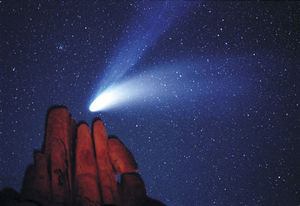
Hale-Bopp, seen here from Joshua Tree National Park, California, was one of the brightest comets of the 20th century.
Few
cosmic apparitions have inspired such awe and fear as comets. The
particularly eye-catching Halley's comet, which last appeared in the
inner solar system in 1986, pops up in the Talmud as "a star
which appears once in seventy years that makes the captains of the
ships err". In 1066, the comet's appearance was seen as a portent of
doom before the Battle of Hastings; in 1456, Pope Callixtus III is said
to have excommunicated it.
Modern science takes a more measured view. Comets such as Halley's are agglomerations of dust and ice
that orbit the sun on highly elliptical paths, acquiring their
spectacular tails in the headwind of charged particles streaming from
the sun. We even know their source: they are Kuiper belt objects (KBOs)
tugged from their regular orbits by Neptune and Uranus.
But there's a problem. Certain comets,
such as Hale-Bopp, which flashed past Earth in 1997, appear simply too
infrequently in our skies. Their orbits must be very long, far too long
to have an origin in the Kuiper belt. The conclusion of many
astronomers is that the known solar system is surrounded in all
directions by a tenuous halo of icy outcasts, thrown from the sun's
immediate vicinity billions of years ago by the gravity of the giant
planets.
This celestial Siberia is known as the Oort cloud,
after the Dutch astronomer Jan Oort, who proposed its existence in
1950. This diffuse
sphere of material encircling the solar system has never been seen, but
if the longest-period comets are anything to go by, it must be vast,
reaching out about 1000 times further than the outer edge of the Kuiper
belt. At such huge distances, it would not be passing planets that
throw the comets sunwards - it would be the tug of the Milky Way and
nearby stars. The Oort cloud would truly be where our solar system meets the void.
Unfortunately, if looking for Planet X is difficult, spotting the Oort
cloud is a nightmare. It is simply too dim and distant, and its pieces
too small, for telescopes to spy. That is unfortunate, as counting and
estimating the size of such objects could help in reconstructing a
picture of the sun's birthplace, and perhaps provide us with a glimpse
of the unadulterated material from which the giant planets were pieced
together.
So far, the only information about this primordial rubble
comes from stray comets and the largest KBOs, which should have a
similar composition. "That's like trying to figure out what a whale
looks like from the exposed blowhole on one side and the tip of the fin
on the other," says Hal Levison, a planetary scientist at the Southwest
Research Institute in Boulder, Colorado.
Even so, mapping the rest of the whale might be only a few
decades off. Oort cloud objects should dim and diffract the light
coming from distant stars. These occultations last just a fraction of a
second, but astronomers can use them to measure the size and distance
of the intervening body, a technique already being put to work on KBOs. Flickers
induced by turbulence in Earth's atmosphere make the subtle detections
of the more distant Oort objects impossible from ground-based detectors, but future space-telescope surveys should be able to detect them in great numbers.
Other mysteries remain. The numbers and trajectories
of the long-period comets seen so far suggest that the Oort cloud
contains trillions of objects a kilometre across or larger, with a
combined mass several times that of Earth. That is more
material than our current ideas about the solar system's formation can
explain - which means that our models might need a fundamental
overhaul, says Levison.
UFOINFO/HBBC UFO Research
Mon, 02 Feb 2009 19:51 UTC
Posted: February 2, 2009
Date: January 13, 2009
Time: 5:20 p.m.
Number of witnesses: 3
Number of objects: 1
Shape of objects: Ball.
Full Description of event/sighting: I was
watching TV in the bedroom when I caught a glimpse, out of the corner
of my eye of what appeared to be a fireball in the sky.
At first I thought it was a plane on fire. So then I
ran down stairs and told everyone in the house to come outside quick.
Three of us saw the light in the sky over Bradford, all of us ruling
out certain things the more we looked at it. The light in the sky
started off way bigger than a plane would appear in the sky and for the
height it was at, but eventually disappeared in front of our eyes.
Before
they brought destruction, a series of huge asteroids orbiting Mars four
billion years ago may have sparked its magnetic field, giving the
planet its greatest chance for harboring life.
Mars has no magnetic field today. Cosmic radiation ravages its
atmosphere and surface, a big reason why it is thought to be
inhospitable to life. But between 4.5 and 4.0 billion years ago, its
core of liquid iron and rock churned with intense heat, creating a
dynamo that raised a protective magnetic force field around the planet.
Then the magnetic field abruptly disappeared, and no one knows why.
Jafar Arkani-Hamed of the University of Toronto thinks the field
could've been powered by between one and four huge asteroids captured
in Mars' orbit. About one percent the size of Earth's moon, any one of
the enormous rocks would have had sufficient gravity to tug on Mars'
core, causing enough convection to create a magnetic dynamo.
"Theoretically, a retrograde orbiting, captured asteroid can
produce a dynamo in the planet," Arkani-Hamed said. "If our moon
orbited against Earth's rotation instead of with it, it could've have
excited the dynamo here."
The asteroids' orbits would've been unstable, though, and
their stints as moons short-lived. After spiraling ever closer to Mars
for 500 million years, they would've shattered into several fragments
before slamming into the planet. Without their immense pull to keep the
dynamo going, Mars' magnetic field would have quickly shut down.
If Arkani-Hamed's theory is right, that would mean some of the 20 or so
giant impact basins on Mars were formed when a few huge asteroids broke
into pieces before landing in a fiery salvo. Many of the basins are
scattered in arc-shaped patterns across the planet, each cluster
suggesting that several rocks all traveled in the same orbital path,
and may have once been one solid mass.
"I don't think it's a crazy idea," Francis Nimmo of the
University of California Santa Cruz, "but the problem you run into is
one of duration."
Phobos, one of Mars' two present-day moons, is also destined
for impact. Arkani-Hamed's theory requires the giant asteroids of
antiquity to power the dynamo for 500 million years before finally
crashing home. Phobos only has about 50 million years before it hits.
Nimmo also noted that not all of the basins in each arc match
up in age, making it tough to argue that the cluster came from the same
original giant rock.
Ian Sample
The Guardian
Wed, 21 Jan 2009 22:55 UTC
A study of lunar craters suggests the side of the moon that now faces Earth was once facing in the opposite direction
The man in the moon may once have faced out to space, until a chance
collision with a giant asteroid billions of years ago, scientists have
found.
A study of the heavily cratered surface has revealed evidence
of a huge impact early in the moon's history that may have been
powerful enough to set it spinning, making its far side periodically
point towards Earth.
Today, the orbit of the moon is such that it always
shows the same face - the near side - to people looking up from Earth.
While the moon does have a "dark side", the side in shadow is
constantly moving, depending on the relative position of the sun.
In the study, scientists at the Paris Institute of Earth
Physics in France analysed the age and locations of 46 craters formed
by asteroids thumping into the moon's surface.
Computer simulations show that if the same face had always
pointed towards us, the moon's western hemisphere as seen from Earth
should be pocked with around a third more craters than the eastern
hemisphere, because the west faces the moon's direction of travel - the
same reason running in the rain will get your front wet more than your
back.
But to their surprise, researchers Mark Wieczorek and Matthieu
le Feuvre found that the craters in the western hemisphere were among
the youngest on the moon, while those in the eastern hemisphere were
much older. The finding, reported in New Scientist magazine, suggests
that the eastern flank was once pummelled by asteroids far more than
the west.
"The simplest interpretation of [our] observations is that the
oldest lunar impact basins formed when the present-day 'nearside' of
the moon was directed away from the Earth and that a single impact
subsequently reoriented the moon about its spin axis by 180 degrees,"
the authors write in the journal Icarus.
The scientists believe that a large asteroid could have
slammed into the moon and set it spinning, so that for tens of
thousands of years it would have appeared to rotate in the night sky.
Craters on the moon that could have been formed by such a
large collision have been dated to around 3.9bn years, soon after it
formed from debris knocked off Earth by an even larger cosmic
collision.
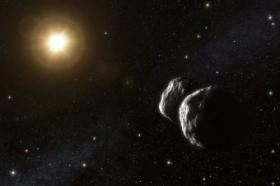
Artist’s
impression of the asteroid (234) Barbara. Thanks to a unique method
that uses ESO’s Very Large Telescope Interferometer, astronomers have
been able to measure sizes of small asteroids in the main belt for the
first time.
A team of French and Italian astronomers
have devised a new method for measuring the size and shape of asteroids
that are too small or too far away for traditional techniques,
increasing the number of asteroids that can be measured by a factor of
several hundred. This method takes advantage of the unique capabilities
of ESO's Very Large Telescope Interferometer (VLTI).
"Knowledge of the sizes and shapes of asteroids is crucial to
understanding how, in the early days of our Solar System, dust and
pebbles collected together to form larger bodies and how collisions and
re-accumulation have since modified them," says Marco Delbo from the
Observatoire de la Côte d'Azur, France, who led the study.
Direct imaging with adaptive optics on the largest
ground-based telescopes such as the Very Large Telescope (VLT) in
Chile, and space telescopes, or radar measurements are the currently
favoured methods of asteroid measurement. However, direct imaging, even
with adaptive optics, is generally limited to the one hundred largest
asteroids of the main belt, while radar measurements are mostly
constrained to observations of near-Earth asteroids that experience
close encounters with our planet.
Delbo and his colleagues have devised a new method
that uses interferometry to resolve asteroids as small as about 15 km
in diameter located in the main asteroid belt, 200 million kilometres
away. This is equivalent to being able to measure the size of a tennis
ball a distance of a thousand kilometres. This technique will not only
increase the number of objects that can be measured dramatically, but,
more importantly, bring small asteroids that are physically very
different from the well studied larger ones into reach.
The interferometric technique combines the light from two or
more telescopes. Astronomers proved their method using ESO's VLTI,
combining the light of two of the VLT's 8.2-metre Unit Telescopes.
"This is equivalent to having vision as sharp as that of a telescope
with a diameter equal to the separation between the two VLT Unit
Telescopes used, in this case, 47 metres," says co-author Sebastiano
Ligori, from INAF-Torino, Italy. The researchers applied their
technique to the main belt asteroid (234) Barbara, which was earlier
found, by co-author Alberto Cellino, to have rather unusual properties.
Although it is so far away, the VLTI observations also revealed that
this object has a peculiar shape. The best fit model is composed of two
bodies each the size of a major city - with diameters of 37 and 21 km -
separated by at least 24 km. "The two parts appear to overlap," says
Delbo, "so the object could be shaped like a gigantic peanut or, it
could be two separate bodies orbiting each other."
If Barbara proves to be a double asteroid, this is even more
significant: by combining the diameter measurements with the parameters
of the orbits, astronomers can then compute the density of these
objects. "Barbara is clearly a high priority target for further
observations," concludes Ligori.
Having proven the validity of their new and powerful
technique, the team can now start a large observing campaign to study
small asteroids.
These observations are presented in a paper by Delbo M. et al., "First VLTI-MIDI direct determinations of asteroid sizes," in press in the Astrophysical Journal.
On Feb. 4th, a team of Italian astronomers witnessed "an intriguing
phenomenon in Comet Lulin's tail." Team leader Ernesto Guido explains:
"We photographed the comet using a remotely-controlled telescope in New
Mexico, and our images clearly showed a disconnection event. While we
were looking, part of the comet's plasma tail was torn away."
Guido and colleagues believe the event was caused by a
magnetic disturbance in the solar wind hitting the comet. It's a
plausible hypothesis. Magnetic mini-storms in comet tails have been
observed before--most famously in 2007 when NASA's STEREO spacecraft
watched a CME crash into Comet Encke. Encke lost its tail in dramatic
fashion, much as Comet Lulin did yesterday.
Browse the gallery to view the comet's tail before, during and after the disconnection event: Comet Lulin Photo Gallery
Marco Island, Florida - Is it a bomb? Is it a plane? Or is it a sonic
boom? Loud bangs have Islanders looking to the sky with wonder.
Comment: How about a meteorite exploding in the upper atmosphere?
Occasional loud booms had Marco Islanders and others in
Southern Collier County wondering what the noise was Wednesday and
Thursday.
Marco Island city officials received several calls about the banging noises, said Public Information Coordinator Lisa Douglass.
Police Chief Thom Carr said officers heard the noise too, but they weren't sure what they were.
Chief Meteorologist Jim Farrell of WINK-TV said his newsroom has
received a few calls from Collier County residents reporting booms as
well.
"Some residents even thought it was an earthquake. We checked
into it and there were no earthquakes in our area," Farrell reported.
He said WINK news reporters believed the noise and vibrations might be coming from a construction site.
More likely it was a sonic boom. A sonic boom refers to the
shocks caused by the supersonic flight of an aircraft. Sonic booms
generate enormous amounts of sound energy, sounding much like an
explosion.
While the military may not confirm or deny any jets in the
area, residents are reporting Air Force sightings off the Gulf coast
the last two days, Douglass said.
"Usually these jets stay out over the Gulf of Mexico, but when
there is cold air in place the sound and vibration can travel quite a
bit," Farrell said.
Authorities are baffled by a mystery explosion that shook the ground around Guanaba, west of the Gold Coast, last night.
A spokesman for the seismological office in Brisbane said their
instruments had not recorded any ground shockwaves, despite dozens of
residents reporting hearing a loud noise and vibrations.
The spokesman said a sonic boom, made by an aircraft going through the sound barrier, may have been the cause.
''There's nothing seismic on the records,'' he said.
''I've looked through continuous data from our recorder at Beenleigh
around the estimated time of the shock waves and nothing has appeared,
which means it wasn't an earthquake but there are still other
possibilities.
''We've previously had a history of things reported from
people in that area that they thought was an earthquake and we've
tracked it down to a sonic boom.''
Air force jets are the only planes capable of breaking the
sound barrier and there has so far been no response to inquiries to the
air force base at Amberley.
The seismology office spokesman said he believed air force
pilots were not supposed to exceed the speed of sound over land, but
sometimes it happened just before they headed their aircraft offshore.
''The results are people will feel windows shaking, that kind of thing,'' he said.
''Our instruments only pick up sound and ground vibrations.
''My understanding is that they're only allowed to break the
sound barrier when flying over the ocean but over land they're not
allowed to go that fast.''
Hinterland properties across Guanaba and Canungra have been rocked by a
mysterious explosion that has left police, fire crews and the
Department of Defence scratching their heads.
Residents have told The Bulletin of a violent shockwave that hit about 8.30pm on Thursday, shattering windows and shaking houses.
The pulse was so strong a demountable building in Coomera Valley Drive shifted on the stumps it was mounted on.
But police have been unable to find any source of an explosion, a seismology expert has ruled out any earth tremor and the Defence
Department is adamant there were no explosions at the nearby Canungra
army base or supersonic aircraft over southeast Queensland on Thursday night.
Guanaba local John Tuminello said the force of the explosion was huge
and he could not believe his two-storey house 'actually vibrated'.
"The house only shook for a split second but it was enough to get the heart going," he said.
"It was just one massive shove, it was amazing.
"There was one huge explosion and then it was all over fairly quickly."
Mr Tuminello said after he felt the shockwave he ran outside to
investigate and could see people with torches in the distance looking
for the cause of the explosion.
Police officers from Canungra and Nerang stations door-knocked the area yesterday and interviewed residents.
Senior Constable Patrick Lyons of Canungra police said officers
were called to investigate the mystery explosion on Thursday night and
were out until 11pm before resuming inquiries yesterday morning.
"Unfortunately the mystery continues," he said. "Where and what has caused this is still undetermined at this stage.
"All the people we've spoken to are of the opinion the blast
came from somewhere in the west and we haven't had any calls from the
other side of the ridge.
"We made contact with the civil aviation authority to see if they had a plane in distress but they had none in the area."
Police investigated the possibility the explosion came from the
Woodlands Retreat construction site, which was in the affected area,
but were unable to find any evidence of a blast.
Nerang officer in charge Peter Gordon said police investigations had come to a 'dead end'.
"There does appear to have been an explosion in that area," said Inspector Gordon.
"Obviously there has been a degree of concern as this is not something you would expect and people got quite a fright.
"But unless we get specific information, we're none the wiser."
Kristy Terry was at home in Coomera Valley Drive, Guanaba, with
her two daughters when the explosion went off, causing one of her
children to hide under her bed in fright.
"The whole house shook like crazy, it was very violent," she said. "It's pretty suspect that nobody has reported anything.
"It could have been the military I suppose, something detonated by accident, but they would have reported it."
A spokesman from the seismology research centre in Brisbane said their instruments had not recorded any ground shockwaves, despite dozens of residents reporting hearing a loud noise and vibrations.
"We've had a history of things reported from people in that
area that they thought was an earthquake and we've tracked it down to a
sonic boom," he said.
A sonic boom is caused when the sound barrier is broken.
Air force jets are the only planes capable of breaking the sound barrier.
The seismology office spokesman said he believed air force
pilots were not supposed to exceed the speed of sound over land, but
sometimes it happened just before they flew their aircraft offshore
from the Amberley Air Force Base.
Comment: It
is very curious how out of all of these explanations, not once is there
a mention that it is possible that it could be a meteorite exploding
above the earth.
The Hindu News
Sat, 07 Feb 2009 11:30 UTC
Space dust interferes with the observation of distant stars and annoys
astronomers just as much as the household variety does.
"We not only do not know what the stuff is, but we do not know where it is made or how it gets into space," said Donald York, professor in astronomy at the University of Chicago.
But now York and University of Toledo's Adolf Witt and their
collaborators have observed a double-star system that displays all the
characteristics that astronomers suspect are associated with dust
production.
One of the double stars is of a type that astronomers
regard as a likely source of dust. These stars, unlike the sun, have
already burned all the hydrogen in their cores. Labelled post-AGB
(post-asymptotic giant branch) stars, these objects collapsed after
burning their initial hydrogen, until they could generate enough heat
to burn a new fuel, helium.
The Astrophysical Journal will publish a paper reporting their discovery in March.
Nancy Atkinson
Universe Today
Sat, 07 Feb 2009 14:23 UTC
While observing a known asteroid on January 31, 2009, astronomer Robert Holmes from the Astronomical Research Institute
near Charleston, Illinois found another high speed object moving nearby
through the same field of view. The object has now been confirmed to be
a previously undiscovered Potentially Hazardous Asteroid (PHA), with
several possible Earth impact risks after 2042. This
relatively small near-Earth asteroid, named 2009 BD81, will make its
closest approach to Earth in 2009 on February 27, passing a comfortable
7 million kilometers away. In 2042, current projections have
it passing within 5.5 Earth radii, (approximately 31,800 km or 19,800
miles) with an even closer approach in 2044. Data from the NASA/JPL
Risk web page show 2009 BD81 to be fairly small, with a diameter of
0.314 km (about 1000 ft.) Holmes, one of the world's most prolific
asteroid spotters, said currently, the chance of this asteroid hitting
Earth in 33 years or so is quite small; the odds are about 1 in 2
million, but follow-up observations are needed to provide precise
calculations of the asteroid's potential future orbital path.
Holmes operates his one-man observatory at ARI, as part of NASA's Near Earth Observation program and the Killer Asteroid Project.
He also produces images for educational and public outreach programs
like the International Astronomical Search Collaboration (IASC) which gives students and teachers the opportunity to make observations and discoveries.
In just the past couple of years, Holmes has found 250 asteroids, 6
supernovae, and one comet (C/2008 N1 (Holmes). However, he said he
would trade all of them for this single important NEO discovery.
"I was doing a follow up observation of asteroid 2008 EV5,"
Holmes told Universe Today, "and there was another object moving right
next to it, so it was a pretty easy observation, actually. But you just
have to be in the right place at the right time. If I had looked a few
hours later, it would have moved away and I wouldn't have seen it."
A
few hours later, a teacher from Texas who was taking part in a training
class on how to use the data that Holmes collects for making
observations used Holmes' data measuring 2008 EV1 and also found the
new object. Shortly after that, a student in Bulgaria that is part of
ARO education and public outreach also noticed the new asteroid. Holmes
listed both observers as co-discovers as well as another astronomer who
made confirmation follow-up observations of what is now 2009 BD81.
Holmes is a tireless observer. Last year alone he made 10,252
follow-up observations on previously discovered NEO's, more than 2000
more than the second ranked observatory, according to the NEO Dynamics website, based in Pisa, Italy.
Holmes has two telescopes, a 24-inch and 32-inch.
He works night-after-night to provide real-time images for the IASC
program, uploading his images constantly during the night to an FTP
site, so students and teachers can access the data and make their own
analysis and observations from them. IASC is a network of observatories
from 13 countries all around the world.
Holmes is proud of the work he does for education, and proud of the students and teachers who participate.
"They do a great job," he said. "A lot of the teachers are
doing this entirely on their own, taking it upon themselves to create a
hands-on research class in their schools." Holmes said recently, two
students that have been involved with IASC in high school decided to
enter the astrophysics program in college.
"I feel like we are making a difference in science and
education," he said, "and it is exciting to feel like you're making a
contribution, not just finding in NEO's but in people's lives."
Holmes also owns some of the faintest observations of anyone in the world.
"My telescopes won't go to 24th magnitude," Holmes said, "but I've got several 23rd magnitudes."
"Getting faint observations is one of the things NASA wants to
achieve, so that's one of the things I worked diligently on," Holmes
continued. The statistics on the site bear that out clearly, which
shows graphs and comparisons of various observatories.
To what does Holmes attribute his success? "It's obviously not
the huge number nights we have in Illinois to work," Holmes said. The
East-Central region of Illinois is known for its hot, humid summer
weather, not conducive for good astronomical "seeing."
"However, I work every single night if it's clear, even if
it's a full moon," he said. "Most observatories typically shut down
three days on either side of a full moon. But I keep working right on
through. I found that with the telescopes I work with, I've been able
to get to the 22nd magnitude even on a full moon night. Last year, I
got about 187 nights of observing, which is the same number as the big
observatories in the Southwest, when you take off the number of cloudy
nights the 6 nights a month they don't' work around full moons.
Sometimes you just have to work harder, and work when others aren't to
be able to catch up. That's how we are able to do it, by working every
single chance we have."
He works alone at the observatory, running the pair of
telescopes, and doing programming on the fly. "I refresh the
confirmation page of new discoveries every hour so I can chase down any
new discovery anyone has found," he said. "If I just pre-programmed
everything I wouldn't have a fraction of the observations I have each
year. I'd miss way too many because some of the objects are moving so
fast."
Holmes said some objects are moving 5,000 arc-seconds an hour
on objects that are really close to Earth. "I've seen them go a full
hour of right ascension per day and that's pretty quick. They can go
across the sky in four or five days," said Holmes. "And there have been
some that have gone from virtually 50 degrees north to 50 degrees south
in one night. That's was a screaming fast object, and you can't
preprogram for something like that, you actually have to be running the
telescope manually."
2009 BD81 is listed as a "risk" object on the NASA/JPL website. This is the 1,015th PHA discovered to date.
"It ranks high as a NEO in general," said Holmes, "although not in a
super-high category as far as the Torino scale," which categorizes the
impact hazard of NEOs. "At this point it's considered a virtual
impactor and that is typically is as high of a rating that you get at
this point."
"Because it is a virtual impactor, it will remain on that
webpage and ask for observations every single night until it is removed
as a virtual impactor or becomes too faint to see," said Holmes. "In
the past year, we've removed 23 virtual hazardous objects, which means
there have been enough observations that the orbit of that object is no
longer considered a threat to our planet."
Because
of the small number of observations of of 2009 BD81, the current chance
of it hitting Earth is small. "The odds are really small right now,"
said Holmes, "however, the smaller your orbital arc is the wider the
path is at that point is of potential impact. The longer the arc gets,
the narrower the cone of opportunity of impact becomes, and once that
cone is no longer pointing at earth in the future, it is removed as a
possible impactor."
Holmes said the excitement of this discovery has been
exhilarating. "It's been a lot of fun. The energy level gets pretty
high when you have something like this show up," he said. "It's pretty rare, and this is the first time I've ever had a NEO discovery.
I've had several hundred asteroids, and just since the beginning of the
school year we have had about 40 asteroids that students and teachers
have discovered in the program. So having this as a NEO is kind of a
nice thing."
Holmes said he'll track 2009 BD81 as long as he possibly can.
Holmes previously was a commercial photographer who had over
4,500 photographs published worldwide in over 50 countries. "At first I
astronomy as a hobby in the evening," said Holmes. "I worked with
schools, who used the data and made some discoveries of supernovae and
asteroids. It came to a point where it was really hard to work all day
as a photographer and work all night in astronomy getting data for
students." So, he chose astronomy over photography.
Holmes now works under a grant from NASA to use astrometry to look for new asteroid discoveries for educational outreach.
One would assume that as a former commercial photographer,
Holmes would attempt to capture the beauty of the night sky in
photographs, but that's not the case.
"The only thing I'm really interesting in is the scientific
and educational aspect of astronomy," said Holmes. "I've never taken a
single color, pretty picture of the sky in the half a million images
I've taken of the sky. It's always been for research or education."
Holmes is considered a professional astronomer by the Minor
Planet Center and International Astronomical Union because he is funded
by NASA, so that means he wasn't eligible to receive the Edgar Wilson
award when he found a comet last year.
Because of Holmes outstanding astronomical work, he is also an
adjunct faculty member in the physics department at Eastern Illinois
University in Charleston, Illinois.
So what really caused the dinosaurs to die out?
Part
of the mystery and allure of dinosaurs is their (relatively) sudden
disappearance from the face of the Earth at the end of the Late
Cretaceous epoch, 65m years ago. Many theories have been expounded to
explain their sudden departure, with more fanciful ones including a
build-up of methane from herbivorous dinosaur farts, mass blindness
from cataracts, or an eradication of plantlife due to a global
infestation of caterpillars.
It is, however, now widely accepted that the most likely cause
of this mass extinction event (which, in fact, not only eradicated
dinosaurs but 75% or more of all land-based animal species) is the
impact of a huge meteorite that struck Earth around the coast of what
is now the Yucatán peninsula in south-east Mexico.
Before there was direct evidence of such an impact,
scientists had already been predicting a giant meteorite strike at this
time due to the large amount of iridium found in the Earth's crust at a
level corresponding to the end of the Cretaceous period (iridium is
more common in meteorites than on Earth, and would have been scattered
over the planet's surface as a fine dust after the meteorite strike).
Then, in the late 1970s, the 110-mile diameter Chicxulub crater was
identified by geophysicist Glen Penfield.
While it is impossible to measure the exact effect of the
Chicxulub meteorite's impact, we know for sure there was a major change
in the planet's ecosystems at this time. The
impact is thought to have thrown a lot of dust into the Earth's
atmosphere, blocking out the sun and causing a sudden cooling event
over much of the planet. This would have meant most plants
could no longer photosynthesise and therefore died off, in turn causing
herbivorous dinosaurs to die out, which would have led to the
eradication of the carnivores, too.
Evidence for such a widespread dying out of plant life has
been collected by palaeontologists studying pollen grains trapped in
rocks from this time. Soon after this event, they found there was a
superabundance of fern pollen, which is indicative of a lack of other
plant life on the planet.
Scientists have speculated that other extreme events at this
time may also have contributed to the disappearance of dinosaurs - for
example, a series of extreme volcanic eruptions in India's Deccan
plateau. But the relative suddenness of dinosaurs' eradication - less
than a million years - implies a more immediate, global catastrophe.
After all, prior to this time there is little evidence that the total
number of dinosaur species had been decreasing significantly.
Despite such a catastrophic event, it is reckoned that between
75% and 90% of fresh-water animal species survived, as opposed to 12%
to 28% of land-based species. This may be explained by the fact that
fresh-water creatures generally don't feed on plantlife, so they would
have, to some extent, been protected from the impact of a major plant
die-off. After the extinction of dinosaurs, small mammals began to
thrive, as did large predatory birds that are themselves now extinct.
The Hindu News
Sun, 08 Feb 2009 15:30 UTC
There is growing evidence that life on earth has come from the universe
through comets, an eminent British scientist said here.
"Life is cosmically abundant and was brought to the earth by
comets and our genes and those of all living forms on earth were
brought by comets, neatly-packaged within cosmic microorganisms,"
professor N Chandra Wickramasinghe, Director, Cardiff Centre for
Atrobiology, Cardiff University, said.
The astrobiologist speaking at Nehru Planetarium said, "Our
genetic ancestors still lurk amidst the stars, and molecular biology is
being deployed to trace connections between different species in search
of a Last Universal Common Ancestor (LUCA) for all life on the Earth."
The evidence for organic molecules that may be
relevant to life emerged after passage of Comet Halley in 1986. Giotto
spacecraft instruments showed that the comet dust contained high molecular weight complex organics that could be connected with degraded biomaterial.
"I shall argue now that comets are responsible for originating life on
a cosmic scale, and distributing it through the cosmos," he said. "Deep
Impact Mission, 4 July 2004, showed comets to be suitable sites for
origin of life, he said. "Comets serve as amplifiers and transporters
of cosmic life (bacteria and viruses) in a freeze-dried state.
"Nearly 5 billion years ago, when the solar system formed from
a cloud like this, life would have already been widespread in the
Galaxy," said the scientist. "The earth and the planets were seeded
with bacteria from solar system's comets, they impacted the earth
nearly 4 billion years ago bringing the first traces of life to our
planet, and thus we have descended from cometary microbes," he said.
When asked can a biological component in comet dust be
discovered by present day experiments, he said, such an experiment was
carried out a few years ago by ISRO scientists collaborating with the
Cardiff University.
The air from the balloon experiment at 41 km in universe
revealed signs of microbial life. There were viable but non-culturable
micro-organisms indicated by the use of fluorescent dyes, he said. The
possibility of an ongoing panspermic input to our planet would have
profound implications for biology, Wickramasinghe said.
Source: Press Trust of India
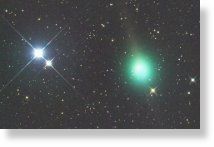
Comet Lulin passing just north of the bright star Zubenelgenubi (alpha2 Librae) on 2/6/09
Comet Lulin (C/2007 N3) is approaching Earth for a 38-million-mile
close encounter on Feb. 24, 2009. At the moment it is glowing like a
6th magnitude star, dimly visible to the unaided eye and a fine target
for binoculars and backyard telescopes.
Comet Lulin is now visible to the naked eye from dark-sky
sites. "This morning, Feb 6th, I noticed a faint smudge above
Zubenelgenubi," reports Jeff Barton from the Comanche Springs Astronomy
Campus in West Texas. "I then trained my 9x63 binoculars on the fuzzy
patch. Yep, nailed it! I was thrilled to finally bag Comet Lulin
without optical aid."
Another naked-eye sighting report comes from Martin
McKenna of Maghera, Northern Ireland: "I went out for a look at Comet
Lulin this morning, Feb. 6th, before dawn with my telescope and
binoculars. The Moon was very low, so I stood within the shadow of my
house and tried to see the comet without optical aid. Using averted
vision, I was able to glimpse the comet perhaps a dozen times! It
looked like a large grey patch of light very close to Zubenelgenubi.
The sight gave me a warm glow on such a frigid frosty night."
New Scientist
Mon, 09 Feb 2009 17:26 UTC

Artist's
concept of a catastrophic asteroid impact with the early Earth. An
impact with a 500 kilometre diameter asteroid would effectively
sterilize the planet. The Earth may have experienced such gigantic
impacts in its youth, but fortunately today there are no projectiles
this large to threaten our planet.
An asteroid that had initially been deemed harmless has turned out
to have a slim chance of hitting Earth in 160 years. While that might
seem a distant threat, there's far less time available to deflect it
off course.
Asteroid 1999 RQ36 was discovered a decade ago, but it was not
considered particularly worrisome since it has no chance of striking
Earth in the next 100 years - the time frame astronomers routinely use
to assess potential threats.
Now, new calculations show a 1 in 1400 chance that it will strike Earth between 2169 and 2199, according to Andrea Milani of the University of Pisa in Italy and colleagues.
With an estimated diameter of 560 metres, 1999 RQ36 is more
than twice the size of the better-known asteroid Apophis, which has a 1
in 45,000 chance of hitting Earth in 2036 (New Scientist, 12 July 2008, p 12). Both are large enough to unleash devastating tsunamis if they were to smash into the ocean.
Although 1999 RQ36's potential collision is late in the next century,
the window of opportunity to deflect it comes much sooner, prior to a
series of close approaches to Earth that the asteroid will make between
2060 and 2080.
Asteroid trajectories are bent by Earth's gravity
during such near misses, and the amount of bending is highly dependent
on how close they get to Earth. A small nudge made ahead of a fly-by
will get amplified into a large change in trajectory afterward. In the
case of 1999 RQ36, a deflection of less than 1 kilometre would be
enough to eliminate any chance of collision in the next century.
But after 2080, the asteroid does not come as close to Earth
before the potential impact, so any mission to deflect it would have to
nudge the asteroid off course by several tens of kilometres - a much
more difficult and expensive proposition.
"That's worth thinking about," says Clark Chapman of the Southwest Research Institute in Boulder, Colorado.
As is often the case, more precise calculations enabled by
future observations will most likely rule out a collision. But Milani's
team says that routine monitoring of asteroids should be extended to
look for potential impacts beyond the 100-year time frame, to identify
any other similar cases.
Comment: More likely the earth will be hit by a comet or cometary debris. For a more in-depth look, read Laura Knight-Jadczyk's Forget About Global Warming: We're One Step From Extinction! or Tunguska, the Horns of the Moon and Evolution.
HBCC UFO Research
Mon, 09 Feb 2009 23:12 UTC
Brian Vike
Date: February 9, 2009
Time: Approx: 4:30 p.m.
Location of Sighting: Chase, B.C.
Number of witnesses: 1
Number of Objects: 1
Shape of Objects: Round ball of fire.
Full Description of Event/Sighting: A ball of fire
shot across the sky in front of my as I was walking down Shuswap Avenue
in Chase, B.C. I was walking from west to east and the ball crossed my
path going from south to north.
It was beautiful. It was crossing through a blue break
in the clouds and it was a bluish colour in the centre and very bright.
It disappeared over the mountains above Star (Aylmer) Lake.
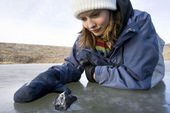
On
Nov. 28, Ellen Milley posed with fragments of a 10-tonne meteorite she
found in a small pond approximately 40 kilometres from Lloydminster,
Sask.
Researchers who found chunks of a meteorite in
Saskatchewan last November believe they're getting close to answering a
key question: where in space did it come from?
University of Calgary graduate student Ellen Milley, who was
part of the team that found space rocks in an area known as Buzzard
Coulee southeast of Lloydminster, was at the University of Saskatchewan
in Saskatoon Monday to talk about what the team has learned.
So far, it looks like the meteorite didn't come from the asteroid belt beyond the orbit of Mars, she said.
The road to reaching that conclusion began when the space rocks fell Nov. 20.
It was a night when hundreds of people across Western Canada
witnessed a spectacular fireball across the sky caused by the estimated
10-tonne rock.
Video surveillance cameras at motels and gas stations
captured the flashes of brilliant light and the shadows they cast. A
week later, Milley was part of the team led by U of C geologist and
geophysicist Alan Hildebrand at Buzzard Coulee. It was she who spotted
the first meteorite fragment in a frozen pond.
Later, she studied the flashes and shadows from the various surveillance and amateur videos.
She used the information to plot the fireball's path as it fell to Earth and then tried to figure out its orbit.
Milley's tentative conclusion, which she discussed in Saskatoon
Monday, was that it didn't look like the space rock came from beyond
the orbit of Mars.
"It looks like it's a very kind of tight inner solar system orbit," she said. "It's not something that's extended into the asteroid belt."
If she's correct, it would be the first time researchers have found debris from a meteorite so close to Earth, Milley said.
In terms of the composition, Milley and her colleagues have
determined it's a relatively common type of meteorite with a high iron
content.
However, there is still much more to learn about it, they say.
More than 100 fragments have already been recovered, but this spring, researchers will be resuming their search for more.
They'll be scouring the fields around Buzzard Coulee in search
of an estimated two tonnes of rock that are believed to be studding the
ground.
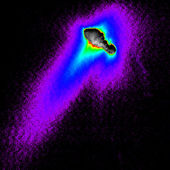
A
composite of images from NASA's Deep Space 1 spacecraft shows features
of comet Borrelly's nucleus. False color is used to reveal details of
the jets and coma.
Swathes of dark comets may be prowling the solar system, posing a deadly threat to Earth.
Hazardous comets and asteroids are monitored by various space agencies
under an umbrella effort known as Spaceguard. The vast majority of
objects found so far are rocky asteroids. Yet UK-based astronomers Bill
Napier at Cardiff University and David Asher at Armagh Observatory in
Northern Ireland claim that many comets could be going undetected. "There is a case to be made that dark, dormant comets are a significant but largely unseen hazard," says Napier.
In previous work, Napier and Janaki Wickramasinghe, also at Cardiff,
have suggested that when the solar system periodically passes through
the galactic plane, it nudges comets in our direction (New Scientist, 19 April 2008, p 10).
These periodic comet showers appear to correlate with the dates
of ancient impact craters found on Earth, which would suggest that most
impactors in the past were comets, not asteroids.
Now Napier and Asher warn that some of these comets may still be
zipping around the solar system. Other observations support their case.
The rate that bright comets enter the solar system implies there should
be around 3000 of them buzzing around, and yet only 25 are known.
We may not see them, say the pair, simply because they are too dark. (Astronomy & Geophysics, link).
Such dark comets are not unheard of. They occur when an "active"
comet's reflective water ice has evaporated away, leaving behind an
organic crust that only reflects a small fraction of light.
In 1983, Comet IRAS-Araki-Alcock passed by Earth at a distance
of 5 million kilometres, the closest known pass by any known comet for
200 years. It was spotted only two weeks ahead of its closest approach.
"It had only 1 per cent of its surface active," says Napier. Comet
Borrelly, visited by NASA's Deep Space 1 probe in 2001, was found to
have extremely dark patches over much of its surface.
"There may be merit to this idea," says Steve Larson of the
University of Arizona's Catalina Sky Survey in Tucson, one of the main
contributors to Spaceguard.
Clark Chapman at the Southwest Research Institute in Boulder,
Colorado, is sceptical, but points out that such dark comets "would
absorb sunlight very well" and so could be detected by the heat they
would emit.
Comment: For more on comets and close calls, see here.
Last Summer's Fireball in Pieces on the Ground?
Anne Minard
Universe Today
Fri, 13 Feb 2009 19:19 UTC
Astronomers have analyzed the cometary fireball that blazed across the
sky over Europe last year and concluded it was a dense object, about a
meter (3.2 feet) across and with a mass of nearly two tons - large
enough that some fragments probably survived intact and fell to the
ground as meteorites.

The
Bejar bolide photographed from Torrelodones, Madrid, Spain. The
incoming fireball is the streak to the right of the floodlit house. The
bright light at the top is the overexposed Moon.
Last
July, people in Spain, Portugal and France watched the brilliant
fireball produced by a boulder crashing down through the Earth's
atmosphere. In a paper to be published in the journal Monthly Notices of the Royal Astronomical Society,
astronomer Josep M. Trigo-Rodríguez, of the Institute of Space Sciences
in Spain, and his co-authors present dramatic images of the event. The
scientists also explain how the boulder may originate from a comet
which broke up nearly 90 years ago, and suggest that chunks of the
boulder (and hence pieces of the comet) are waiting to be found on the
ground.
"If we are right, then by monitoring future encounters with
other clouds of cometary debris, we have the chance to recover
meteorites from specific comets and analyse them in a lab," Dr
Trigo-Rodríguez said. "Handling pieces of comet would fulfil the
long-held ambitions of scientists - it would effectively give us a look
inside some of the most enigmatic objects in the Solar System."
Fireballs (or bolides) are the name given by
astronomers to the brightest meteors, popularly referred to as shooting
stars. On the afternoon of July 11, a brilliant fireball was recorded
over southwestern Europe. At maximum intensity, the object was more
than 150 times brighter than the full Moon. It was first picked up at a
height of 61 miles (98.3 km) and disappeared from view 13 miles (21.5
km) above the surface of the Earth, tracked by three stations of the
Spanish Fireball Network above Bejar, near Salamanca in Spain. At the
same time, a professional photographer took a picture of the fireball
from the north of Madrid.
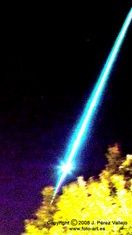
A close-up image of the Bejar bolide, photographed from Torrelodones, Madrid, Spain.
From
these images, the astronomers have demonstrated that before its fiery
demise, the boulder traveled on an unusual orbit around the Sun, which
took it from beyond the orbit of Jupiter to the vicinity of Earth. This
orbit is very similar to that of a cloud of meteoroids known as the
Omicron Draconids, which on rare occasions produces a minor meteor
shower and probably originates from the breakup of Comet C/1919 Q2
Metcalf in 1920. The authors suggest the boulder was once embedded in
the nucleus of that comet.
Comet C/1919 Q2 Metcalf was discovered by Joel Metcalf from
Vermont in August 1919, and was visible until February 3, 1920. The
orbit was not well determined and no subsequent appearances are known.
The Omicron Draconids meteor stream was discovered to be following a
similar orbit to this comet by Allan F. Cook in 1973. The stream
characteristically produces bright fireballs and rare meteor outbursts.
In the mid-1980s, the astronomers Tamas I. Gombosi and Harry
L.F. Houpis first suggested that the nuclei of comets consist of
relatively large boulders cemented together by a 'glue' of smaller
particles and ice. If the rocky and icy nucleus of a comet
disintegrates, then these large boulders are set loose into space. If
the Bejar bolide was formed in this way, it confirms the glue model for
at least some comets.
Science Daily
Sat, 14 Feb 2009 18:28 UTC
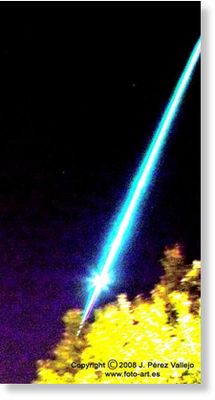
A close-up image of the Bejar bolide, photographed from Torrelodones, Madrid, Spain.
Last July, people in Spain, Portugal and France watched the
brilliant fireball produced by a boulder crashing down through the
Earth's atmosphere. In a paper to be published in the journal Monthly Notices of the Royal Astronomical Society,
astronomers Josep M. Trigo-Rodríguez (Institute of Space Sciences,
CSIC-IEEC, Spain), José M. Madiedo (University of Huelva-CIECEM, Spain)
and Iwan P. Williams (Queen Mary, University of London) present
dramatic images of this event.
The scientists go on to explain how the boulder may originate
from a comet which broke up nearly 90 years ago and suggest the
tantalising possibility that chunks of the boulder (and hence pieces of
the comet) are waiting to be found on the ground.
Fireballs (or bolides) are the name given by
astronomers to the brightest meteors (popularly referred to as
'shooting stars'). On 11th July 2008, at 2117 GMT, a brilliant fireball
was recorded. At maximum intensity, the object was more than 150 times
as bright as the full Moon. It was first picked up at a height of 98.3
km and disappeared from view 21.5 km above the surface of the Earth,
tracked by three stations of the Spanish Fireball Network (SPMN) above
Bejar, near Salamanca in Spain. At the same time a professional
photographer took a picture of the bolide from the north of Madrid.
From these images, the astronomers can deduce the trajectory
and properties of the incoming boulder. The team think it was a dense
object, about 1 metre across and with a mass of 1.8 tonnes, large
enough that some fragments probably survived intact and fell to the
ground as meteorites.
The astronomers demonstrate that before its fiery demise, the
boulder travelled on an unusual orbit around the Sun, on a path which
took it from beyond the orbit of Jupiter to the vicinity of the Earth.
This orbit is very similar to that of a cloud of dusty particles
(meteoroids) known as the Omicron Draconids, which on rare occasions
produces a minor meteor shower and probably originates from the breakup
of Comet C/1919 Q2 Metcalf in 1920. This strongly suggests that the
boulder was once embedded in the nucleus of that comet.
In the mid-1980s the astronomers Tamas I. Gombosi and Harry
L.F. Houpis first suggested that the nuclei of comets consist of
relatively large boulders cemented together by a 'glue' of smaller
particles and ice. If the rocky and icy nucleus of a comet
disintegrates, then these large boulders are set loose into space. If
the Bejar bolide was formed in this way, then it confirms the glue
model for at least some comets.
And if fragments of the bolide can be recovered, then for the
first time, scientists will be able to study large pieces from a comet
in a laboratory. Dr Trigo-Rodríguez comments "If we are right, then by
monitoring future encounters with other clouds of cometary debris, we
have the chance to recover meteorites from specific comets and analyse
them in a lab. Handling pieces of comet would fulfil the long-held
ambitions of scientists - it would effectively give us a look inside
some of the most enigmatic objects in the Solar System."
Journal reference:
1. Trigo-Rodríguez et al. Observations of a very bright fireball and its likely link with comet C/1919 Q2 Metcalf. Monthly Notices of the Royal Astronomical Society, 2009; DOI: [link]
WBIR Channel 10
Sat, 14 Feb 2009 18:28 UTC
Liz Overton
Many viewers have contacted 10 News since Friday evening saying they
saw a bright light go across the sky at about 10 p.m. Friday evening.
Some described the light as a greenish color, others said it was white, and some said it had a blue appearance.
Paul Lewis, University of Tennessee Space Science Outreach
program director, did not see the light, but said the descriptions he
received indicate it may have been a meteor.
We are not in the midst of a meteor shower at this time, but Lewis said random meteors do come down periodically.
From a description of the angle of the light and because it went across
the sky, Lewis believes the meteor would have probably touched down
hundreds of miles away from East Tennessee, but more likely burned up
in the atmosphere.
Lewis is not sure what debris would have been contained in the
meteor, but said it is probably too soon to include debris from the
satellite collision that happened nearly 500 miles above Siberia on
Tuesday.
Fox News
Sun, 15 Feb 2009 23:55 UTC
Police scanner traffic in Texas was abuzz Sunday morning with reports
of fireballs or burning debris in the sky. Residents in Hill and
Navarro counties also reported hearing an explosion or feeling their
house shake.
The Federal Aviation Administration's spokesman Roland Herwig
attributed the reports to falling debris from a recent satellite
collision.
According to the Associated Press, a derelict
Russian spacecraft designed for military communications and a working
satellite owned by U.S.-based Iridium, which served commercial
customers as well as the U.S. Department of Defense, collided over
Siberia on Tuesday.
Herwig said airmen were warned that crash debris might
fall this weekend. He said he started receiving calls at about 11 a.m.
Sunday from law enforcement agencies across the state. The agencies
were fielding questions from people who had either witness or found
fallen debris.
"We don't know what has fallen yet. We'll find out in a day or so what we are looking at," he said.
He encouraged residents to call police and use caution around any debris that they may find on their property.
Earlier this week the chief of Russia's Mission Control said
clouds of debris from the collision will circle Earth for thousands of
years and threaten numerous satellites, the Associated Press reported.
HBCC UFO Research
Sun, 15 Feb 2009 20:00 UTC
Brian Vike
Date: February 14, 2009
Time: 7:00 p.m. to 11:00 p.m.
Location of Sighting: Whitby Ontario Canada west sky.
Number of witnesses: 3
Number of Objects: 1
Shape of Objects: Triangular.
Full Description of Event/Sighting: I noticed a very
bright star in the western sky last night around 7:00pm. The sky was
clear and the object seemed to actually cast a very wide beam. After
looking at the light for a while, I thought that perhaps it was a
helicopter with a search light on. My daughter joined me and the light
didn't move for a further 20 minutes. We then looked at it through
binoculars and could both see a leading, very bright light like a huge
fire or search light. The remainder of the overall triangular shape
seemed to consist of either a number of smaller triangles or flame
streaks of blue and orange.
The object seemed to maintain position and
configuration for the duration of our observations. We stopped checking
around 11:00pm. We took a photo of the light at around 9:00pm, but it
just looks like a bright light in a dark sky.
I was just outside tonight and noticed that this light
phenomenon is no longer in the sky. Have you hear any other like
reports? Was there a comet in the sky last night? Wondering what we
saw.
My San Antonio News
Sun, 15 Feb 2009 09:55 UTC
Colin McDonald
It streaked across the Central Texas sky Sunday morning in a bright
yellow flash with a boom, leaving a trail of smoke. The FAA thought it
might be from Russia.
The media, bloggers and the Twitterverse followed the feds' lead.
But they were all wrong.
It turned out it wasn't debris from Tuesday's collision of two
satellites over Russia after all, according to the Domestic Events
Network of the Federal Aviation Administration.
Federal authorities now believe the source was not manmade.
On Saturday, the FAA issued a notice for pilots to be on the lookout
for falling space debris until further notice. On Sunday night, that
notice was removed and being rewritten to attribute the concern to a "natural source."
Both the U.S. Strategic Command and North American Aerospace Defense
Command said the fireball seen across Central and South Texas at 11
a.m. Sunday had nothing to do with the remnants of the abandoned
Russian satellite and a working satellite owned by U.S.-based Iridium
Satellite LLC. They collided Tuesday.
STRATCOM has been following the debris field from the
satellites since it was created and said it was nowhere near Texas.
NORAD said it was not tracking any debris over North America at that
time.
According to witnesses, the streak appeared for a few seconds
and was followed by either an explosion or a rumbling sound like the
passing of a jet. It left a trail of smoke.
Austin Marathon fans reported seeing the streak while watching the race.
"The only reason I noticed it was I was looking way down the road," said Matt Stiles, a reporter with the Houston Chronicle who was in Austin to cheer for a friend in the race. "I saw it and kind of had to do a double take, and then it was gone."
At the same time, the FAA received reports from residents and
police agencies across Central and South Texas of a similar meteor-like
flash or "a fireball" accompanied by a loud noise.
Stiles said that what he saw reminded him of the streaks he saw from the space shuttle Columbia crash Feb. 1, 2003.
Earlier, FAA spokesman Roland Herwig said he did not know where his agency got the information it based its notice on.
Meteors hit Earth's atmosphere every day, and most are smaller
than a grain of sand and go unnoticed, said Joe Wheelock, a spokesman
for the McDonald Observatory, near Fort Davis.
While seeing one in the daytime is rare and usually difficult
because the sun outshines the light from the meteor, it does happen,
Wheelock said.
"All a fireball is, is a really bright meteor burning up in the atmosphere," he said.
Even the flash Sunday was not bright enough for everyone to see.
While Stiles was comparing notes with others who had seen and
heard the same thing he did, his girlfriend standing next to him did
not believe him.
"It was funny," he said. "Even after the guy next to me said he heard the same thing, she did not believe me."
Brian Vike
HBCC UFO Research
Sun, 15 Feb 2009 23:00 UTC
Date: February 14, 2009
Time: 11:00 p.m.
Location of Sighting: Alliston, ON.
Number of witnesses: 1
Number of Objects: 1
Shape of Objects: Round.
Full Description of Event/Sighting: Around 11:00pm I
went outside for a smoke, I looked up and it was rather cloudy, but I
could see an orange ball in the clouds. I saw this before in
Allisten,Ontario. It stayed for only a few minutes and it was gone.
It was the same flaming red/orange ball I saw before
around the camp fire when a beam of light came down on us. This was in
2006-2007.
HBCC UFO Research
Sun, 15 Feb 2009 23:00 UTC
Brian Vike
Date: February 14, 2009
Time: 7:30 p.m.
Location of Sighting: Woodbridge, Ontario.
Number of witnesses: 4
Number of Objects: 3
Shape of Objects: Round?
Full Description of Event/Sighting: I was leaving the
house to go to store and noticed a bright light. I thought it was a
plane heading towards me in the sky and didn't think twice. I left and
came back. I was gone about 30 minutes and upon entering the house the
light was still there. Later (about an hour) my wife said while I was
gone she went outside and seen this really bright light. (white) She
watched it and it was staying in the same area. She then called my
mother and father who were visiting, outside to see. My wife and I went
back outside to look again after we talked the object was still there,
but not as close so it didn't look so bright.
There were two other smaller lights that were blinking
very close to the other larger object. We didn't even think to get a
picture, just dismissed it as an airplane or something.
Sky News
Mon, 16 Feb 2009 13:30 UTC
Authorities in Texas are baffled after being flooded with reports of burning debris falling from the sky.
Terrified onlookers were heard screaming when the mysterious "fireballs" were filmed mid-morning on Sunday.
They were captured by television cameras recording a marathon in the state capital Austin.
No one has explained where the debris has come from, amid numerous reports of sightings to the Federal Aviation Administration.
The city's Sheriff's Office sent up a helicopter to investigate but it returned with no hard evidence.
There were initial concerns the fireballs originated from a collision
of two space satellites last week. A US and a Russian communication
satellite smashed together 500 miles above Earth.
But US Strategic Command has since said the two incidents are unrelated.
The Federal Aviation Administration said it had warned pilots
to be aware of possible space debris following the satellite collision.
Russia's Mission Control chief said clouds of debris will
circle the planet for thousands of years and threaten numerous
satellites.
The debris field from the collision is described as huge but
scientists are still trying to determine the full scope of the crash.
Houston Chronicle
Mon, 16 Feb 2009 15:55 UTC
Susan Carroll and Jennifer Latson
The U.S. Strategic Command said there was no connection to reports of a
"fireball" in the sky over Texas on Sunday and Tuesday's collision of
satellites from the U.S. and Russia.
"There is no correlation between the debris from that
collision and those reports of re-entry," said Maj. Regina Winchester,
of STRATCOM.
The Federal Aviation Administration fielded calls from
across Texas Sunday morning with sightings of a "fireball" in the sky.
Callers also reported hearing an "explosion," probably a sonic boom
caused from an object moving faster than the speed of sound, said
Roland Herwig, an FAA spokesman.
In Williamson County, callers thought they had seen a plane
crash. The Sheriff's Office even sent its helicopter out to look for
wreckage.
A chief of staff for Mayor Bill White, Michael Moore, said a
blindingly bright flash made its way across his windshield in a matter
of seconds. It seemed nearby, but Moore realized it had to be closer to
heaven than Earth to appear so clearly in the morning sky.
"It's hard to compete with the sun," said Moore.
Moore was just leaving Austin when he saw the bright blip in the sky around 11 a.m. He assumed it was an unusually large meteor.
The FAA issued a nationwide notice for all pilots and air crews
to be on the lookout for "potential space debris" after Tuesday's
collision. The satellites crashed nearly 500 miles above northern
Siberia, creating debris clouds that will circle Earth for thousands of
years and threaten numerous satellites, according to the chief of
Russia's Mission Control.
The Associated Press contributed to this report.
Flashback:
Ice Age Ends Smashingly: Did a comet blow up over eastern Canada?
Sid Perkins
Science News
Sun, 03 Jun 2007 08:02 UTC
Evidence unearthed at more than two dozen sites across North America
suggests that an extraterrestrial object exploded in Earth's atmosphere
above Canada about 12,900 years ago, just as the climate was warming at
the end of the last ice age. The explosion sparked immense wildfires,
devastated North America's ecosystems and prehistoric cultures, and
triggered a millennium-long cold spell, scientists say.
At sites stretching from California to the Carolinas and as far
north as Alberta and Saskatchewan - many of which were home to
prehistoric people of the Clovis culture - researchers have long noted
an enigmatic layer of carbon-rich sediment that was laid down nearly 13
millennia ago. "Clovis artifacts are never found above this black mat,"
says Allen West, a geophysicist with Geoscience Consulting in Dewey,
Ariz. The layer, typically a few millimeters thick, lies between older,
underlying strata that are chock-full of mammoth bones and younger,
fossilfree sediments immediately above, he notes.
New analyses of samples taken from 26 of those sites reveal
several hallmarks of an extraterrestrial object's impact, West and his
colleagues reported at the spring meeting of the American Geophysical
Union in Acapulco, Mexico.
Samples from the base of the black mat yield most of the clues
to its extraterrestrial origin, says Richard B. Firestone, West's
coworker and a nuclear physicist at the Lawrence Berkeley (Calif.)
National Laboratory. Some of the particles there are small, magnetic
grains of material with higher proportions of iridium than are found in
Earth's crust, he notes.
Also in the mat's base are tiny lumps of glasslike carbon that
probably formed from molten droplets of the element. These lumps, as
well as little spheres of carbon with a different microstructure,
contain nanoscale diamonds formed under intense pressure.
A host of unusual geological features, collectively known as
Carolina Bays, hints at the cataclysm's location, says team member
George A. Howard, a wetland manager at Restoration Systems, an
environmental-restoration firm in Raleigh, N.C. Around 1 million of
these elliptical, sand-rimmed depressions, measuring between 50 meters
and 11 kilometers across, scar the landscape from New Jersey to
Florida. In samples taken from 15 of the features, Howard and his
colleagues found iridium-rich magnetic grains and carbon spherules with
tiny diamond fragments similar to those found at Clovis archaeological
sites.
The long axes of the great majority of the Carolina Bays point
toward locations near the Great Lakes and in Canada - a hint that the
extraterrestrial object disintegrated over those locales, says Howard.
Because scientists "haven't discovered a large, smoking hole"
left by the event, the object that blew up in the atmosphere probably
was a comet, says West.
Heat from the event would have set off wildfires across the
continent, the scientists suggest. The heat and shock from the
explosion probably broke up portions of the ice sheet smothering
eastern Canada at the time, they add. The flood of fresh water into the
North Atlantic that resulted would have interrupted ocean currents that
bring warmth to the region, and thick clouds of smoke and soot in the
air would have intensified cooling across the Northern Hemisphere.
The inferred date of the event matches the beginning of a
1,200-year-long cold spell that geologists call the Younger Dryas,
which in its first few decades saw temperatures in the Northern
Hemisphere drop as much as 10°C.
Nuclear blasts proposed for warding off menacing asteroids
Contra Costa Times
Tue, 17 Feb 2009 09:00 UTC
Suzanne Bohan
After a 200-foot-wide meteorite sped toward the ground near the
Tunguska River in 1908, it unleashed an explosion in the remote Russian
region 500 times more powerful than the bomb dropped on Hiroshima. The
blast, called the Tunguska Event, was detected in London by monitoring
equipment, and it leveled millions of trees over an 830-square-mile
area.
Had the meteorite hit a populated area such as London, the result would have been a catastrophe.
It's that rare but plausible scenario of a large meteorite
striking an increasingly crowded Earth that has a network of
scientists, including David Dearborn of Lawrence Livermore Laboratory,
devising strategies to monitor and then thwart these celestial menaces.
Dearborn, a research physicist, spoke at three free
seminars Saturday in Livermore, describing his strategy for using
nuclear blasts to prevent devastating meteorite strikes on Earth.
Throughout the ages, asteroids circling the sun have
intersected Earth's orbit and entered the atmosphere. Most of them are
so small they quickly burn up in a blaze, giving us a brief glimpse of
their final moments, which we call shooting stars. But about every 500
to 1,500 years, Dearborn said, larger ones the size of the Tunguska
meteorite reach Earth. And every year, smaller ones carrying a lesser
but still potent punch get through, although most hit the ocean or
remote terrestrial regions.
"It's not uncommon," he said.
And sometimes they do hit populated areas, Dearborn added. "Cars have actually been hit by meteorites."
When they hit, these cosmic bodies leave "impact craters" or
can create tsunamis if they land in the ocean. There are about 170
known impact craters, including the 120-mile-diameter Chicxulub crater
on the Yucatán Peninsula in Mexico, and many thousands that either
eroded away or remain undetected on land or the ocean floor. The huge
meteorite creating the Chicxulub crater struck 65 million years ago,
and scientists believe it brought about the extinction of the
dinosaurs, along with three-quarters of life on Earth, by radically
altering the atmosphere by kicking up clouds of dust and sulfur gases.
An event that size is expected every 50 million to 100 million years,
the NASA stated.
Hundreds of thousands of asteroids form a belt that circles
the sun from Mars to Jupiter, and they range in size from less than a
mile in diameter to nearly 500 miles across. In the 1990s, scientists
started paying more attention to the dangers posed by this asteroid
belt, Dearborn said. Now about 4,500 of them are deemed "near-Earth
objects" that are likely to cross Earth's path at some point, or get
dangerously close.
Dearborn proposes sending spacecraft bearing nuclear
explosives to an asteroid identified as a threat by a NASA program
called "Space Guard." The program is tasked with tracking near-Earth
asteroids larger than 1 kilometer. Congress asked NASA to create the
program in 2005.
The nuclear blasts could change the speed of the asteroid
enough to prevent it from slamming into Earth, much like slowing down
or speeding up a car to stop it from striking another object.
Nuclear material has the advantage of packing far more energy
into it per ton than any comparable explosive material - a key
consideration on weight-conscious space missions, Dearborn said.
Detractors of this approach worry about the spread of radioactive
material in space with such a system, but Dearborn said it would be
detonated so far out that minuscule amounts - far less than that found
naturally on Earth - would reach the atmosphere. Others are leery of
former weapons being used in the neutral realm of outer space. NASA,
however, in a 2007 report described the use of nuclear blasts as the
best approach for handling threatening asteroids.
Other strategies under consideration include using a gravity
tracker, which could slightly alter an asteroid's trajectory by
exerting on it the gravitational pull of nearby spacecraft, although
Dearborn said that approach is marred by the enormous fuel requirements
of such spacecraft.
Dearborn, however, pointed out that with the Space Guard
program, there's ample time to prepare for a threatening asteroid or
comet, since they can be detected decades in advance. "We'll have time
to think about all sorts of things," Dearborn said. What's most
critical, he said, is to maintain the monitoring system.
"With the warning, you have options."
Argentina: More Fireballs Reported
Tue, 17 Feb 2009 16:42 UTC
Inexplicata
Just
as television viewers everywhere marvel about the daylight
meteor/fireball/unknown object videotaped over Texas, Inexplicata has
received an e-mail posting from Jorge Luis Figueras, photographic
analyst with the Fundacion Argentina de Ovnilogia (FAO):
"[The incidents] occurred on Saturday, and regional members of the FAO
are involved in researching it. At this time, eyewitness accounts span
locations as distant as Casa de Piedra in the south of La Pampa, Viedma
in eastern Rio Negro, Sierra Grande and Ramos Mexia, Cutral Co,
Bariloche on the western end of the province, Neuquén proper, Zapala,
Las Lajas and Chos Malal -- that is to say, two entire provinces 600
kilometers from north to south and some 500 from east to west. There is
a strong likelihood that it was also seen in Chile.
"Witnesses I've been with up to this moment (my wife
included) total five in Cipolletti (the approximate center of the
sighting) and suggest an angle greater than 45 degrees west. In Viedma
they're saying 30 degrees in the same direction. All agree on the white
light that turned to blue and finally to greenish blue, with an
approximate duration of between 5 to 10 seconds. Some witnesses - not
all - report hearing a detonation. But only a few have said this."
Inexplicata
Tue, 17 Feb 2009 16:52 UTC
Neuquen - Three unidentified objects entered the atmosphere, creating a
tremendous flash that lit the region's skies from Alto Valle to the
Cordilleran Lake region, according to witnesses.
The phenomenon occurred on Saturday night between 22:15 and
23:00 hours and was confirmed by the Neuquén Astronomical Observatory
and the Bariloche Naval Prefecture. Roberto Figueroa, director of the
Observatory, told Rio Negro Online that "around 22:15 I was in the
observatory with some people and we suddenly saw how the entire sky in
the western part of Parque Norte became illuminated. We saw three very
bright objects, unidentified, which exploded upon entering the
atmosphere, producing a tremendous flash that was followed by a sort of
smoke."
He ratified that these were unidentified flying
objects, and he understands that it could have been "a large asteroid
measuring between 5 and 8 meters in diameter. It would be one of many
that cross Earth's path as collision point. As they enter our
atmosphere, they heat up and expand in such a way that they wind up
burning up and falling as ashes," explained Figueroa. "However, it
could also have been the reentry of one of many satellites orbiting the
earth." The expert concluded by saying that there "are no specifics to
what actually seen."
From Bariloche, residents and tourists claimed seeing a light
fall to earth in Lake Nahuel Huapi. According to the Bariloche News
Agency, members of the Naval Prefecture reported receiving calls from
several residents, including some who were in Lake Mascardi and claimed
seeing "a flashing light."
The Prefecture believed at first that it was a flare and sent
a vessel to survey the area toward the Limay River as indicated by
callers, but nothing was found. "We supposed that it was a shooting
star, but do not have any solid data on what occurred."
A group of fishermen at the Piedra del Aguila area also
confirmed the sighting, but added the detail that it was followed by a
loud report. In Roca, residents celebrating the Fiesta Nacional de la
Manzana (Apple Day) also witnessed the phenomenon. "It was a greenish
blue object that seemed to be made of metal," said a woman.
This sighting has occurred only days away from the first
collision in space produced by cosmic traffic. The collision, which
occurred last Tuesday and was reported on Friday, involved two
satellites - one Russian, the other American, which impacted some 800
km over Siberia.
Brad Franko
WBCD TV News
Tue, 17 Feb 2009 17:27 UTC
A
You on 2 report from Summerville shows a scene similar to one that
played out in Texas over the weekend. A bright orange fireball
streaking across the sky.
There were original reports that debris from the collision of
U.S. and Russian satellites were the culprit...but those reports have
since been refuted.
Afton Dewland sent this email along with the picture:
Good morning.
I was at the bus stop this morning with my son and so something that looked like a shooting star in the trees
Maybe you can tell me what this is? I have attached a picture.
Storm Team 2 Chief Meteorologist Rob Fowler did some research and found this explanation from Spaceweather.com:
Weekend Fireballs: A daylight fireball
over Texas on Sunday, Feb. 15th, triggered widespread reports that
debris from a recent satellite collision was falling to Earth. Those
reports were premature. Researchers have studied video of the event and
concluded that the object was more likely a natural meteoroid about one
meter wide traveling more than 20 km/s - much faster than orbital
debris. Meteoroids hit Earth every day, and the Texas fireball was
apparently one of them.
There's more: On Friday, Feb. 13th, people in central
Kentucky heard loud booms, felt their houses shake, and saw a fireball
streaking through the sky. This occurred scant hours after another fireball at least 10 times brighter than a full Moon lit up the sky over Italy.
Although it is tempting to attribute these events to debris from the
Feb. 10th collision of the Iridium 33 and Kosmos 2251 satellites, the
Kentucky and Italy fireballs also seem to be meteoroids, not manmade
objects. Italian scientists are studying the ground track of their
fireball, which was recorded by multiple cameras, and they will soon
begin to hunt for meteorites.
Comment: Here's info on the Texas fireball in case you missed it.
Seth Borenstein
The Huffington Post
Tue, 17 Feb 2009 09:27 UTC
An odd, greenish backward-flying comet is zipping by Earth this
month, as it takes its only trip toward the sun from the farthest edges
of the solar system. The comet is called Lulin, and there's a chance it
can be seen with the naked eye - far from city lights, astronomers say.
But you'll most likely need a telescope, or at least binoculars, to
spot it.
The best opportunity is just before dawn one-third of the way
up the southern sky. It should be near Saturn and two bright stars,
Spica and Regula.
On Monday at 10:43 p.m. EST, it will be 38 million
miles from Earth, the closest it will ever get, according to Donald
Yeomans, manager of NASA's Near Earth Object program.
The story behind the comet is more intriguing than its
appearance - the greenish tinge may be hard for many to discern. The
color comes from a type of carbon and cyanogen, a poisonous gas.
Lulin was discovered by a Chinese teenager two years ago. It
still has many of its original gases - gases that are usually stripped
away as comets near the sun. Unlike most comets viewable from Earth,
this one hasn't been this close to the sun before, Yeomans said.
While all the planets and most of the other objects in the
solar system circle the sun counterclockwise, Lulin circles clockwise,
said NASA astronomer Stephen Edberg. And thanks to an optical illusion,
from Earth it appears as if the comet's tail is in the front as the
comet approaches Earth and the sun.
"It essentially is going backwards through the solar system," he said.
It came from the outskirts of the solar system, 18 trillion
miles away. Once it's made the journey around the sun, Lulin will gain
enough speed to escape the solar system, Edberg said.
"If you are interested in comets, make sure you see it," he
said. "But it's not going to be a real great blast for the general
public."
Meteors Light Up Kentucky's Skies
Tue, 17 Feb 2009 15:21 UTC
WBKO
Astronomers say bright lights in the sky and noises like thunder observed over much of Kentucky were meteors.
The Lexington Herald-Leader reported that after the
reports came in from people in Kentucky and Texas late Friday, the
Federal Aviation Administration cautioned pilots to beware of satellite
debris, but the advisory was quickly withdrawn.
FAA spokeswoman Kathleen Bergen said it was a natural phenomenon.
University of Kentucky astronomy professor Tom Troland told the
newspaper meteors are seen routinely and are occasionally very bright
and cause a noise much like a sonic boom.
The Web site SpaceWeather.com reported three meteors were seen burning up over Italy hours before the streaks of light were seen over Kentucky.
On the evening of Tuesday the 10th, and on the morning after, the
phones at the observatory were ringing busily. People from all over the
Okanagan were phoning in with reports of something they saw in the sky.
This account is distilled from all those reports, and describes a large
fireball, or bolide.
At about 4:30 p.m., an extremely bright, starlike object
appeared in the sky over the Northern or Central Okanagan, which was
seen from as far south as Okanagan Falls, south of Penticton. Leaving a
short, glowing trail, it crossed the sky heading in a westerly
direction. Some observers reported that when it was close to the
western horizon, it exploded into many fragments. One report came from
100 Mile House, About 80 km north-west of Kamloops, and described loud
booms, like thunder. Obviously, something had come into the Earth's
atmosphere at very high speed. Friction made it white hot and
evaporated part of it, leaving a trail. Finally it exploded.
The two main possibilities are that it was either a
piece of something of ours coming back to Earth, or that it was the
arrival of a lump of rock or iron, material left over from the
formation of the Solar System. At this point we don't know for sure,
but there are strong clues. Firstly,
it was going in a westerly direction. We rarely launch any spacecraft
into orbit in that direction because if we launch them towards the
east, we get several hundred kilometres an hour free from the rotation
of the Earth. If we launch things the other way, we have to work
against the Earth's rotation. That suggests the object was not one of
ours. In addition, the sightings suggest the object was in a
dive. Objects returning from orbit will be moving almost horizontally
or in a very shallow dive during the burning up part of the re-entry.
An exception could be a space probe or launcher rocket associated with
an interplanetary space mission, but we don't know of any suitable
candidate. It is most likely that the object was a lump of rock maybe
the size of a suitcase, moving at somewhere between 30,000 and 100,000
km/h.
In space the rock was pretty cold. Then, when it entered the
thin, upper atmosphere, friction heated the outside until it was white
hot. Rock is not a good conductor of heat, so the inside remained cold.
However, the temperature difference between the inside and outside
would have produced a lot of stress. As the object dived more deeply
into the atmosphere, the denser air imposed a savage drag on it, making
it decelerate so hard that if one of us were sitting inside we would
have been flattened. The object settled into a minimum drag
configuration as it fell. Eventually the thermal and deceleration
stresses became strong enough to break off a piece. This unbalanced the
drag forces, sending the object into a supersonic tumble, which tore it
to pieces. This probably caused the booms that were heard up at Hundred
Mile House. As a very rough guess, the fragments would have landed
somewhere close to the area defined by Kelowna, Penticton, Kamloops and
Princeton. However in the thickly forested terrain, there's little
chance of finding anything. Of course, I missed the event.
The planet Venus still dominates the southwestern sky until
quite late in the evening. Saturn rises around 8 pm. The Moon will be
New on the 24th.
Ken Tapping is an astronomer with the National Research Council's
Herzberg Institute of Astrophysics, and is based at the Dominion Radio
Astrophysical Observatory, Penticton, BC, V2A 6J9.
Mass Extinctions May Follow One - Two Punch
Michael Reilly
Discovery News
Tue, 17 Feb 2009 16:51 UTC
As agents of extinction, comet and asteroid impacts may be losing their punch.
According to a new theory about how mass dyings work, cosmic collisions
generally aren't enough to cause a major extinction event. To
be truly devastating, they must be accompanied by another event that
inflicts long-term suffering, like runaway climate change due to
massive volcanic eruptions.
In other words, a comet couldn't have killed the dinosaurs by itself -- unless they were already endangered species.
This kind of one-two punch could explain more than the extinction of
dinosaurs, Nan Arens of Hobart and William Smith Colleges said. In a
recent paper in the journal Paleobiology,
she and colleague Ian West argue that there are two types of events
that can cause extinctions -- "pulses" (quick, deadly shocks, like
comets) and "presses" (drawn-out stresses that push ecosystems to the
brink but may not kill outright, like million-year-long volcanic
eruptions).
The chances of mass dyings go way up when both happen together, argues Arens.
But are all mass extinctions created equal? Can researchers come up with a "Grand Unified Theory" of ancient apocalypse?
West and Arens think so. They combed the last 300 million years
of geologic record, noting impact craters, massive eruptions, periods
of ancient climate change, and then comparing them to extinctions. The
rate at which species die off spiked dramatically, they found, when a
"pulse"-type event occurred within a million years or so of a "press."
The theory fits well for the dinosaurs. Around the time of
their demise 65 million years ago, a comet slammed into the Yucatan
Peninsula and a huge volcano, the Deccan Traps, was erupting in what is
today India.
But other extinctions are problematic. The greatest dying in
geologic history, the Permian-Triassic extinction, killed 90 percent of
all life on Earth, but there is no record of an impact. Instead, all
signs point to a 200,000-year-long volcanic eruption in Siberia as the
murder weapon.
Arens' theory argues that impacts are weaker in effect than is
generally thought. But a growing consensus of researchers believes that
doesn't go far enough. They believe eruptions, not cosmic impacts, are
the real killers.
"I'm not so sure craters really have anything to do with it,"
Gregory Retallack of the University of Oregon said, adding: "I don't
like the 'press' term very much. If you look closely at the isotope
record, you can see that flood basalts [large-scale eruptions] are a
series of pulses, paving the golden path toward annihilation."
"I'm not saying it's impossible to have an extinction with
just a 'press' or a 'pulse' event," Arens admitted. The study states
only that it's more likely when the two combine.
Humanity is creating exactly that scenario today, she said.
Over the last 6,000 years, subsistence farming began changing the
climate and clearing wilderness slowly enough to constitute
'press'-type stresses on the environment. But people began burning
fossil fuels in earnest during the Industrial Revolution, and carbon
concentrations have skyrocketed while growing population numbers have
led to widespread habitat loss around the globe.
Arens argued this constitutes a 'pulse' event, and the sixth great mass extinction may already be underway.
US: Fireball Lights Up Hawaii Sky and Causes Jaws to Drop
Star-Bulletin
Fri, 20 Feb 2009 10:30 UTC
Helen Altonn and Leila Fujimori
Flashy, colorful fireball awes sky-gazers.
"Look out!" shouted Gregory McCartney, who runs astronomy education
programs at Ko Olina, as a fireball flew overhead. He thought his group
of 18 was about to be hit, but the mysterious object suddenly
disappeared.
Another isle resident who saw the green fireball in the sky the night
of Feb. 9 "thought the world was coming to an end." Joanna Spofford,
walking with her 3-year-old daughter in Kalama Valley, said, "It was
the scariest thing in the world." Astronomers said the celestial
apparition could have been a new meteor, possibly from "a clump of
cometary material that hadn't dispersed enough to become an annual
shower."
One thing it was not: debris from the collision of U.S. and Russian
satellites. That collision did not happen until the next day.
Some people reported seeing a green fireball. Others said it was orange and "scary."
They didn't know what they were looking at about 9 p.m. Feb. 9.
It was a show-stopper for Gregory McCartney, who runs an evening
outdoor astronomy education and entertainment program at Ko Olina.
The NASA Solar System ambassador and board member for the
University of Hawaii Friends of the Institute for Astronomy Council had
about 18 people at a star show that night.
He said they were waiting for Saturn to come into view at
about 9:05 p.m. "when all of a sudden, out of nowhere this streaking
bullet of a meteor comes ripping across the sky over the Marriott Beach
Club timeshare building (from the east) heading downwards at a
45-degree angle towards the ocean (the west)."
He was facing north when he saw it, he said, explaining he usually yells out to the crowd when he sees a "shooting star."
"However, as this meteor came closer to the crowd about two
palm trees in height, it suddenly lit up brighter than a full moon as
in a glow larger than I'd say a house," he wrote in an e-mail. "I mean,
this thing was the largest, brightest meteor I had ever seen.
"It was literally white hot and amazingly clear white - not like milk
color, but more like a glossy brilliance. As it went over a palm tree,
this time I instinctively yelled, 'Look out!' as it seemed we were
about to be hit.
"Then it lit up into a brilliant clear blue color for a split second, then a brilliant red and disappeared."
McCartney and his clients were not alone in witnessing the
heavenly phenomenon. People elsewhere on Oahu and throughout the nation
reported seeing similar events.
The Federal Aviation Administration had calls from media
across the country asking about flashes in the sky that night, a
spokesman said, adding that he believed it was a "meteorological phenomenon."
UH astronomer David Tholen said it possibly was "a new meteor shower
from a clump of cometary material that has not yet dispersed enough to
become an annual shower."
Barry Peckham, Hawaiian Astronomical Society vice president,
said, "It probably was a fireball...You can see that most any night.
You just have to be looking up, which very few people do."
A fireball is "just a rock falling to Earth," he said. "It's
very bright and lasts anywhere from one second to maybe four seconds at
the most. It throws off what would look like sparks, and it makes a
tail; sometimes there's a smoke stream that follows it. Very often the
head is orange. Very often the tail is green."
Peckham said fireballs "can explode, and then pieces go flying
in different directions. And that all happens in just a couple of
seconds." But they usually disintegrate before hitting the earth, he
said.
McCartney said he does not know whether the meteor he saw landed in the sand or the ocean or whether it made it to the ground.
"It definitely stole Saturn's thunder in ending our show," he
said. "At least half the group of folks with me saw this, and everyone
was literally stunned and breathless with shocked, frozen smiles on
their faces in awe."
Joanna Spofford, 32, was walking with her 3-year-old daughter,
Journey, in their Kalama Valley neighborhood in Hawaii Kai that night
when she saw a green object in the sky.
"It was the scariest thing in the world," she said. "I thought
the world was coming to an end. I never experienced anything similar to
that."
Spofford said she had read about the Oklahoma fireball, a
bright meteor seen Feb. 15 over that state and Texas, but "this
disappeared right in front of us."
Mahea Mahiai, 25, said she heard a sound like some electrical short circuit in Kalihi Valley at about 11 that night.
Suddenly she saw "a bright orange light, like a fireball, kind
of, just a glow of orange light, but it happened so fast." She thought
it fell, hitting the ground or something in the air.
Mahiai said her father told her kahunas are capable of sending
out fireballs, "akulele," and wherever one lands, somebody is going to
die.
Richard Wainscoat, with the UH Institute for Astronomy, said
he had a class on Feb. 11 at Sandy Beach, and the students saw more
meteors than usual.
There are no meteor showers this time of year, but sporadic
meteors occur year-round that are not associated with any particular
shower, he said.
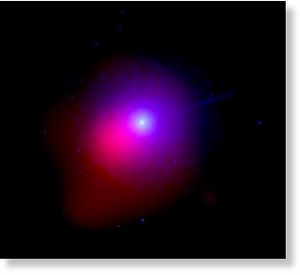
This
image of Comet Lulin taken Jan. 28 merges data acquired by Swift's
Ultraviolet/Optical Telescope (blue and green) and X-Ray Telescope
(red). At the time of the observation, the comet was 99.5 million miles
from Earth and 115.3 million miles from the sun.
While waiting for high-energy outbursts and cosmic explosions,
NASA's Swift Gamma-ray Explorer satellite is monitoring Comet Lulin as
it closes on Earth. For the first time, astronomers are seeing
simultaneous ultraviolet and X-ray images of a comet.
"We won't be able to send a space probe to Comet Lulin, but Swift is
giving us some of the information we would get from just such a
mission," said Jenny Carter, at the University of Leicester, U.K., who
is leading the study.
"The comet is releasing a great amount of gas, which makes it
an ideal target for X-ray observations," said Andrew Read, also at
Leicester.
A comet is a clump of frozen gases mixed with dust. These
"dirty snowballs" cast off gas and dust whenever they venture near the
sun. Comet Lulin, which is formally known as C/2007 N3, was discovered
last year by astronomers at Taiwan's Lulin Observatory. The comet is
now faintly visible from a dark site. Lulin will pass closest to Earth
-- 38 million miles, or about 160 times farther than the moon -- late
on the evening of Feb. 23 for North America.
On Jan. 28, Swift trained its Ultraviolet/Optical
Telescope (UVOT) and X-Ray Telescope (XRT) on Comet Lulin. "The comet
is quite active," said team member Dennis Bodewits, a NASA Postdoctoral
Fellow at the Goddard Space Flight Center in Greenbelt, Md. "The UVOT
data show that Lulin was shedding nearly 800 gallons of water each
second." That's enough to fill an Olympic-size swimming pool in less
than 15 minutes.
Swift can't see water directly. But ultraviolet light from the
sun quickly breaks apart water molecules into hydrogen atoms and
hydroxyl (OH) molecules. Swift's UVOT detects the hydroxyl molecules,
and its images of Lulin reveal a hydroxyl cloud spanning nearly 250,000
miles, or slightly greater than the distance between Earth and the
moon.
The UVOT includes a prism-like device called a grism, which
separates incoming light by wavelength. The grism's range includes
wavelengths in which the hydroxyl molecule is most active. "This gives
us a unique view into the types and quantities of gas a comet produces,
which gives us clues about the origin of comets and the solar system,"
Bodewits explains. Swift is currently the only space observatory
covering this wavelength range.
In the Swift images, the comet's tail extends off to the
right. Solar radiation pushes icy grains away from the comet. As the
grains gradually evaporate, they create a thin hydroxyl tail.
Farther from the comet, even the hydroxyl molecule succumbs to
solar ultraviolet radiation. It breaks into its constituent oxygen and
hydrogen atoms. "The solar wind -- a fast-moving stream of particles
from the sun -- interacts with the comet's broader cloud of atoms. This
causes the solar wind to light up with X rays, and that's what Swift's
XRT sees," said Stefan Immler, also at Goddard.
This interaction, called charge exchange, results in X-rays
from most comets when they pass within about three times Earth's
distance from the sun. Because Lulin is so active, its atomic cloud is
especially dense. As a result, the X-ray-emitting region extends far
sunward of the comet.
"We are looking forward to future observations of Comet Lulin,
when we hope to get better X-ray data to help us determine its makeup,"
noted Carter. "They will allow us to build up a more complete 3-D
picture of the comet during its flight through the solar system."
Other members of the team include Michael Mumma and Geronimo Villanueva at Goddard.
NASA's Goddard Space Flight Center in Greenbelt, Md., manages
the Swift satellite. It is being operated in collaboration with
partners in the U.S., the United Kingdom, Italy, Germany and Japan.
NASA's Fermi Gamma-ray Space Telescope is an astrophysics and particle
physics observatory developed in collaboration with the U.S. Department
of Energy and with important contributions from academic institutions
and partners in France, Germany, Italy, Japan, Sweden, and the U.S.
Images
Found: Pieces of space rock 2008 TC3 once seen heading for Earth
New Scientist
Fri, 20 Feb 2009 16:22 UTC
David Shiga
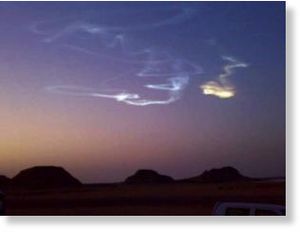
The
small asteroid 2008 TC3 broke up in the atmosphere above Sudan on 7
October and left behind this wind-blown trail high in the sky.
The discovery of meteorites from an asteroid that exploded over
Sudan in October completes an astronomical trifecta. For the first
time, scientists have detected a space rock ahead of a collision with
Earth, watched it streak through the atmosphere, and then recovered
pieces of it. Analysis of the meteorites could shed light on conditions
in the early solar system more than 4 billion years ago.
When the asteroid,
called 2008 TC3, was discovered on 6 October last year, it was just 20
hours away from hitting Earth. Though the warning period was short, it
was the first time a space rock had been found before it impacted the
planet.
Orbital calculations predicted the object would plunge into
the atmosphere above Sudan at 0246 GMT on 7 October, and it arrived
right on time. Observations suggested it was no more than 5 metres
across, too small to survive intact all the way to the ground and cause
damage.
The brilliant fireball it made as it descended through
the atmosphere was seen far in the distance by the crew of a KLM
airliner, and was observed by various satellites, including a weather
satellite called Meteosat-8.
Now, a team of meteorite hunters has found fragments of the
object. The meteorites are a unique group in that they come from an
object seen hurtling through space before its plunge into Earth's
atmosphere.
Numerous fragments
Students from the University of Khartoum, led by Dr Muawia
Shaddad, found the first fragments using data provided by NASA to hone
in on where fragments were likely to be found.
Scientists involved with the discovery, including Peter
Jenniskens of the SETI Institute in Mountain View, California, have
reportedly submitted a study about the find to a scientific journal,
and have not responded to interview requests.
But Lindley Johnson, head of NASA's Near-Earth Object Program
office at the agency's headquarters in Washington, DC, reported the
find on Monday in Vienna, at a United Nations meeting discussing
near-Earth object (NEO) impacts. An image of the first fragment found
is included in the slides from Johnson's presentation (pdf) (see slide 19).
Donald Yeomans, who manages NASA's efforts to find and track NEOs at
the Jet Propulsion Laboratory (JPL) in Pasadena, California, confirmed that "quite a few" fragments have been found but declined to discuss them further.
Weak material?
Before the fragments were found, meteorite expert Peter Brown of the
University of Western Ontario in Canada said the asteroid was likely
made of relatively weak material, given that 2008 TC3 broke up
unusually quickly once it hit the atmosphere, exploding about 37
kilometres above ground.
Another object known to have broken up at about this height
scattered fragments over Tagish Lake in Canada in 2000. The Tagish Lake
meteorites turned out to be made of a very crumbly material, and fall
into a class of meteorites called carbonaceous chondrites, which have
been modified little by heat or other processes since the solar system
formed more than 4.5 billion years ago.
"I would caution making direct compositional comparisons [with
the Tagish Lake meteorites], but it does certainly underscore the
global weakness of [2008 TC3]," Brown said in comments
posted on the JPL website in November. He added that observations of
the rock's quick breakup "all but rule out" a composition rich in iron.
Point of origin
When the analysis of these rock fragments does come out, what
is it likely to tell us? Meteorites in general provide a valuable
record of conditions in the early solar system, such as temperature and
chemical composition.
And the 2008 TC3 meteorites could be especially illuminating
because the parent object was observed in space before the breakup,
allowing scientists to calculate its former orbit around the Sun. This
provides precious information connecting the meteorites to their place
of origin in the solar system.
For most other meteorites, such calculations involve a lot of
guesswork. Meteorites had previously been recovered after about 10
"fireball" events, where parent space rocks were observed streaking
through the sky.
But in those cases, scientists had to try to reconstruct the object's orbit based on its path through the atmosphere.
"It's often very difficult to get from a streak in the sky to
what the orbit was," says Allan Treiman of the Lunar and Planetary
Institute in Tucson, Arizona. "But if they've got its location before
it hit the atmosphere, they're far better off - that's really
wonderful."
It's a bird. It's a plane. It's ... a UFO?
That suspicion crossed David Kent's mind when he spotted a bright
turquoise ball in the sky Wednesday night from his Hockinson,
Washington home. Kent saw the object travel across the sky before
disappearing a few seconds later. He quickly dismissed the UFO idea,
though.
"I don't believe in that stuff," Kent said.
Experts don't believe what Kent saw was a UFO either, but said
it's likely space debris or a fireball, otherwise known as a
brighter-than-normal meteor. The National Weather Service didn't have
reports of anyone else seeing the object.
Jim Todd, Oregon Museum of Science and Industry's
planetarium manager, said that based on Kent's description of the
object, he believed it could be pieces of broken satellite. But Todd
hadn't heard any other reports and said he was simply offering
conjecture.
"It may have been something very natural: A shooting star,
Venus or a plane in the distance," Todd said. "A blue color is
characteristic of broken up space debris."
While an amateur astronomer in Spokane this week spotted the
remote comet Lulin, which is passing Earth over the next few weeks,
Todd said it's doubtful that's what Kent saw.
"Lulin is very faint because it's far, far away," Todd said. "And it doesn't move as fast as this person described."
Kent, who lives off Northeast 184th Street, said he was on his
deck at about 9:30 p.m., when he looked south toward trees and saw a
vibrant ball passing east to west. At first, he thought it was a plane,
but realized it was too big to be one. He also dismissed it being a
shooting star.
"I see falling stars every once in a while, but they drop off quickly," he said. "This was a pretty big sized ball."
Star Tribune
Fri, 20 Feb 2009 21:31 UTC
Bob Von Sternberg
The enduring mystery of the south Minneapolis explosions that are
rattling both windows and neighbors' nerves has once again reared its
head.
A new spate of nighttime blasts, roughly 100, have been going
off since summer, something that has been occurring intermittently for
nearly three years.
The last time police investigated the spate of explosions, in
2006 and 2007, they were finally able to determine the source: plain,
old fireworks, most likely set off by teenagers.
This time, though, only about half can be explained away, said
Lt. Dean Christiansen, who's coordinating the investigation in the
Third Precinct.
Fireworks and exploding electrical transformers
account for the explained half, "but for the rest, we just don't know,"
he said. "We can't explain it."
The most troubling, if far-fetched, theory -- that anarchists
were in the Mississippi River gorge, practicing their explosive skills
in preparation for the Republican National Convention -- didn't pan
out.
"It was a real homeland security concern so we were down there
in the river with the St. Paul cops, but that wasn't it," Christiansen
said.
Undercover cops have been working the neighborhoods where the blasts have been reported, but have enjoyed only mixed success.
For example, on Monday shortly after midnight, three explosions
were reported and were quickly determined to be fireworks. Two more
reported several hours later remain head scratchers.
"There's one theory that competing groups of some kind are
trying to see who can come up with the loudest explosions down by the
river," Christiansen said.
Another theory that didn't hold was the possibility that some
unknown kind of chemical reaction was occurring in the city's water
treatment system.
Although most appear to be occurring near the river, sound
echo patterns have sent the noise across a wide swath of the city along
the river from roughly E. Lake Street to Ford Parkway. And they've been
heard by residents dozens of blocks to the west.
Just like in 2007, news of the explosions has spread like
electronic wildfire among residents, who have lit up neighborhood
e-mail lists with their accounts of the noise. Last time, theories ran
from pipe bombs to sonic booms to exploding gas lines.
This time, the theories have run more along the lines of propane cannons, and violent freight train car coupling.
That was offered by Standish-Ericsson neighborhood resident
Geoff Garton, who added, "sounds can play some amazing tricks,
ricocheting around the city."
Police are continuing their investigation, with no suspects so far, Christiansen said.
Flashback:
Asteroid 2008 TC3 Strikes Earth: Predictions and Observations Agree
Steve Chesley, Paul Chodas, and Don Yeomans
National Aeronautics and Space Administration
Tue, 04 Nov 2008 16:45 UTC
A spectacular fireball lit up the predawn sky above Northern Sudan on
October 7, 2008. This explosion was caused by the atmospheric entry of
a small near-Earth asteroid, estimated to be no more than a few meters
in diameter. The explosion likely scattered small meteorite fragments
across the Nubian desert below. Although such small impact events occur
several times per year around the globe, this case was unprecedented
because the asteroid was actually discovered the day before it reached
the Earth and the impact location and time were for the first time
predicted in advance.
At 6:39 UT (UT = GMT) on the morning of October 6, 2008, Richard
Kowalski, at the Catalina Sky Survey, discovered this small near-Earth
asteroid using the Mt. Lemmon 1.5 meter aperture telescope near Tucson,
Arizona. When the discovery observations were reported to the Minor
Planet Center (MPC) in Cambridge Massachusetts, a preliminary orbit
computation immediately indicated that the object was headed for an
Earth impact within 21 hours. The MPC quickly made the discovery and
subsequent "follow-up" observations available to the astronomical
community and contacted the NASA/JPL Near-Earth Object Program Office.
The MPC also notified NASA Headquarters of the impending impact so that
subsequent US government interagency alerts and inter-governmental
notifications could begin. By the time this object (now designated as
2008 TC3) entered the Earth's shadow 19 hours after discovery, some 570
astrometric (positional) measurements had been reported from 26
observatories around the world, both professional and amateur.
Within an hour of receiving the initial data set, JPL
predicted that the object would enter the Earth's atmosphere above
northern Sudan around 02:46 UT on October 7. As the day progressed and
more and more data arrived from the MPC, JPL continued to improve the
orbit for 2008 TC3 and forwarded updated predictions to NASA
Headquarters. On the afternoon of Oct 6th, NASA Headquarters alerted
officials at the National Security Council, the Office of Science and
Technology Policy, the Department of State, and the Department of
Defense Northern Command and Joint Space Operations Center. NASA also
issued a press release at approximately 21:30 UT announcing the
predicted impact later that night.
Detections of the actual atmospheric impact event suggested that it was
an airburst explosion at an altitude of 37 km with an energy equivalent
to about one kiloton of TNT explosives. The time and place of the
predicted impact agree very well with a number of atmospheric entry
observations including those from U.S. government satellites,
infrasound signals from at least one ground station, images from the
Meteosat 8 weather satellite and a sighting by a KLM airline pilot
flying over Chad. The latest JPL trajectory estimate, which carefully
considers all available data, including some measurements not available
until after the event, is accurate to within a few kilometers at the
time of atmospheric entry.
This dramatic prediction of an actual impact underscored the successful
evolution of the Near-Earth Object (NEO) Program's discovery and orbit
prediction process. The discovery was made, observations were provided
by 26 international observatories, the orbit and impact computations
were determined, verified and announced well before the impact, which
took place only 20.5 hours after the discovery itself. While
improvements to the impact prediction process still need to be made,
the system worked well for the first predicted impact by a near-Earth
object.
Circumstances of the Earth impact:
The relative velocity of the 2008 TC3 as it entered the atmosphere was
12.4 km/s. It was on a shallow, near-grazing impact, arriving from a
direction 20.0 degrees above horizontal and from an azimuth of 281.6
degrees, which is nearly west to east. Based on the measured brightness
of the object in space, and assuming typical reflectance properties of
near-Earth asteroids, it was estimated to be in the range of 2-5 meters
in diameter. This places the kinetic energy at around 1 kiloton of TNT,
give or take a factor of two. Analyses of detections of the entry by
U.S. government satellites and ground-based very low frequency
infrasound measurements also suggest a total kinetic energy of about 1
kT (Brown, 2008a,b,c; Johnson, 2008).
Harris (2008) provided information on the object's light curve, which
indicates a rapidly tumbling spin state. Marek Kozubal and Ron
Dantowitz, two Massachusetts amateur astronomers, observed 2008 TC3
with a fast read out photometer. They supplied these photometric data
to Al Harris who de-trended these data for 3 magnitudes of brightening,
and then sent his results to Petr Pravec who ran the light curve
analysis and determined the object was in a non-principal axis rotation
state (i.e., it was tumbling or wobbling) with the two principal
rotation periods being 97 and 49 seconds. Figures 1a and 1b provide
illustrations of the asteroid's approach to Earth. Note that the object
entered the Earth's shadow at 01:49 UT, nearly an hour before
atmospheric entry, so that ground-based astrometric observations ceased
at that point.
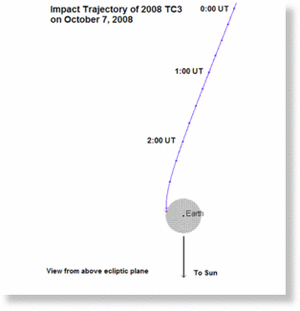
Figure 1a. The terminal trajectory for Earth impacting asteroid 2008 TC3. The view is looking down on the ecliptic plane.
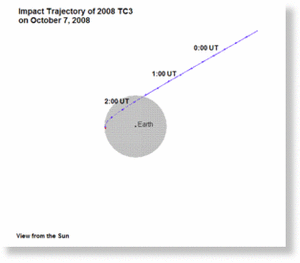
Figure
1b. The terminal trajectory for Earth impacting asteroid 2008 TC3. The
view is from the sun. Note that the asteroid enters Earth shadow at
about 1:49 UT so that the final portion of the trajectory is behind the
Earth.
Table 1. The observed times and locations of
atmospheric entry and airburst reported by US government satellites are
compared to the JPL trajectory predictions for the same altitude. There
is excellent agreement especially in light of the observed time
uncertainty introduced by round off and the necessarily imprecise
nature of the observed events. The observed data were taken from Brown
(2008a) and Johnson (2008).
| Event | Atmospheric Entry | Airburst Detonation |
|---|---|---|
| Altitude (km) | 65.4 | 37 |
| Observed Event Time (UT) | 02:45:40 | 02: 45:45 |
| Predicted Event Time (UT) | 02:45:38. 45 | 02:45:45.13 |
| Observed Long./Lat. (deg.) | 31.4E 20.9N | 32.2E 20.8N |
| Predicted Long./Lat. (deg.) | 31.412E 20.933N | 32.140E 20.793N |
Figure 2 provides the latitude and longitude coordinates for the
object's positions at 10 km increments from 100 km altitude down to the
surface. Although atmospheric effects were not considered, the
predicted positions of the object agree well with the reported
atmospheric coordinates for atmospheric entry (at 65.4 km) and the
airburst event (at 37 km), which are plotted as red stars on the
illustration. Figure 3 presents the uncertainty footprint of the impact
predictions for an altitude of 50 km.
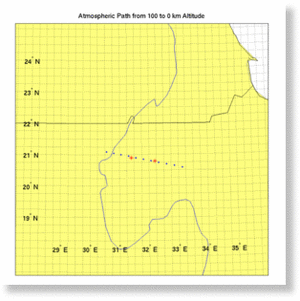
Figure
2. The predicted path of the asteroid is noted at 10 km intervals from
100 to 0 km altitude, neglecting atmospheric drag. The red dots
indicate the reported instances of atmospheric entry at 65.4 km
altitude and for the airburst at 37 km.
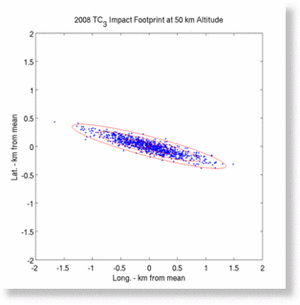
Figure
3,. Dispersion of 900 variant orbits, all of which could fit the
existing observational data, at an altitude of 50 km. The nominal (most
likely) position is denoted by the red dot in the center of the
diagram. The results of this Monte Carlo simulation demonstrate that
most possible orbits fell within 1 km from the mean, which is at
(31.804°E, 20.858°N). The 1-, 2- and 3-sigma uncertainty ellipses are
noted in red. Statistically and respectively, these ellipses capture
39%, 86% and 99% of the cases. The time of impact uncertainty at a
given altitude is 0.16 seconds, 1-sigma.
The Observed Effects of Impact:
The fireball event was observed visually, in the infrared, and by very low frequency infrasound devices.
Borovicka (2008) reported visual and infrared observations of the event
taken from the Meteosat 8 satellite on October 7 at approximately 2:45
UT. The spot (see Figure 4) was apparent in all 12 satellite spectral
channels, spanning wavelengths from the visible to infrared. The
estimated timing and position in the Meteosat 8 images is imprecise,
but roughly consistent with the JPL orbit estimate.

Figure 4. Meteosat 8 / EUMETSAT infrared image of the 2008 TC3 explosion. The scale at the right gives the image intensity.
Brown (2008a) provides information on the event derived from U.S.
Government satellites (See Table 1). Elsewhere, he reported that the
radiated energy was equivalent to approximately 0.1 kT (Brown 2008b),
which is again consistent with an overall kinetic energy of about 1 kT.
Brown also suggested that 2008 TC3 had a rather low mechanical
strength, saying "the height which is quoted for the detonation (37 km)
is unusually high for an object of this energy and (from the orbit
solutions) low entry velocity. This is almost exactly the same initial
burst height as recorded for the (faster) Tagish Lake fireball, which
also had the same entry angle. I would caution making direct
compositional comparisons, but it does certainly underscore the global
weakness of the object compared to chondritic objects and I think can
be used to all but rule out something as strong as an iron (for
example)."
Kuiper (2008) reported that the pilot and co-pilot for a KLM flight
over Chad saw the impact flash after they had been alerted to watch for
the event. Captain Ron de Poorter and co-pilot Coen van Uden were
flying their 747-400 from Johannesburg to Amsterdam during that night
of Oct 6th -7th. When they received the alert-message about 2008 TC3
from the KLM dispatcher, their position was over Chad. At 0244 UT they
began continuously observing the horizon in the east-north-east sector
of their sight. They had put the received coordinates in their
navigation system and concluded that, compared to their plane's heading
(which was at that moment 348 degrees, almost NNW), they had to look at
a bearing of 68-70 degrees, in clockwise terms looking at 'half past
two'. At UT 02:45:40 seconds they saw the sky above the part of the
horizon they were looking at, suddenly brightening by a light flash. In
approximately one and a half seconds, this "lightning" was 2 to 3 times
more visible.
A clever, remote use of an Egyptian webcam on a Red Sea beach may have
captured the flash from the airburst. The web cam was located some 725
km north of the impact site and was pointed away from the impact
direction. Nevertheless, the camera did capture the brightening of
foreground objects illuminated by the flash. See [link].
Brown (2008c) reported that preliminary examinations of several
infrasound stations nearest to the predicted impact point for the NEO
2008 TC3 has yielded at least two definite airwave detection from the
impact. The data are consistent with the predicted arrival direction
and time and suggest a kinetic energy of about 1.1 - 2.1 kilotons of
TNT.
References:
Brown, Peter (2008a). [link]
Brown, Peter (2008b). Email received October 7, 2008.
Brown, Peter (2008c). Email received Oct. 9, 2008
Borovicka (2008). Event reported on IAU Circular 8994, Central Bureau
of Astronomical Telegrams, Smithsonian Astrophysical Observatory,
Cambridge, MA, Oct. 8, 2008.
Harris, Alan (2008). Results reported at the Oct. 2008 AAS Division of Planetary Sciences Conference at Cornell University.
Johnson, Lindley (2008). Email received by D.K. Yeomans on Oct. 7, 2008.
Kuiper, Jacob (2008). Emailed report received by D.K. Yeomans on Oct. 16, 2008 es Conference at Cornell University.
Johnson, Lindley (2008). Email received by D.K. Yeomans on Oct. 7, 2008.
Kuiper, Jacob (2008). Emailed report received by D.K. Yeomans on Oct. 16, 2008
Johnson, Lindley (2008). Email received by D.K. Yeomans on Oct. 7, 2008.
Kuiper, Jacob (2008). Emailed report received by D.K. Yeomans on Oct. 16, 2008
Witnesses
to the phenomenon in Esquel and El Bolsón (Chubut Province) claim that
the "night was completely lit" - it occurred last Saturday and research
is ongoing to determine if it was a meteorite that entered the
atmosphere and disintegrated, or if it was a UFO.
The strange "fireball" that crossed the skies over the
Cordillera in Chubut between the towns of Esquel and El Bolsón is being
investigated to see if it was an Unidentified Flying Object (UFO) or a
meteorite that entered the atmosphere and burned up before striking the
ground.
The episode took place at midnight last Saturday -
although it only became known today - and was seen by at least a dozen
people driving along the road that links El Bolsón with Esquel.
Those who witnessed the phenomenon claimed that the dark night
was almost entirely illuminated for a few seconds, leaving eyewitnesses
"flabbergasted"
"On Saturday, between 23:00 and midnight, personnel on duty
saw a fireball-type light," said Ramon Lotero, second commander of the
36ths Squadron of the National Gendarmes.
"The duty officer went out to survey the vicinity, because we
first thought it was a private plane, but nothing could be seen,"
Lotero said in a statement reproduced by www.paginasdelsur.com.ar
website. While there wasn't much certainty about what occurred, the Air
Force wasn't able to explain it either. Lotero leaned toward the
meteorite theory.
"In theory, it was a fireball. We speculated that it was a
meteorite. We cannot say this but in theory we believe it was a
meteorite. Had it been a small plane, it would have left some traces,
and we looked for the spot where it could've fallen, but there was
nothing there," he added.
Drivers transiting at that time at the entrance to Esquel "also saw the same".
The second commander estimated - based on the observations -
that "the fireball" fell between El Bolsón and San Carlos de Bariloche,
although he could not be more specific. "When the object was seen, Air
Force personnel working at the local airport was contacted, but no
further information was obtained," Loreto pointed out.
Source: INFOBAE de Buenos Aires
WVLT-TV
Sat, 21 Feb 2009 21:20 UTC
Stephen McLamb
It's startling residents, making houses shake, and causing the 911
phone lines to light up as they did on Monday and Thursday.
There's no doubt folks that live along South Ruth and South Cedar are hearing something.
They made 9-1-1 calls.
But there hasn't been an earthquake, a sonic boom, or any kind of accident near there.
As to what it is, it's as clear as mud.
The neighborhood between Maryville high school and the middle school is a quiet neighborhood, usually.
But Monday morning and Thursday night, residents there heard explosions captured by 911 phone calls.
"Caller: There was a huge boom and my whole house just shook!"
"Caller: We keep on hearing, our houses are shaking up here. We don't know what's going on!"
"Caller: We're hearing and feeling, like, major explosions!
911 Dispatcher: Yes, ma'am. We're had several calls on it. We're trying to figure out where it's coming from."
Residents in the area say it was no small event.
"A violent boom, like a car running into your house," says David Headrick, whose wife made a 911 call.
"A big boom, just like dynamite went off," says Charlie Haun, who thought something blew up in his basement.
"The floor of the living room, which is like made out of wood,
you could feel it vibrate through the floor," says Dr. Susan Smith, who
heard both Monday and Thursday's explosions.
Emergency vehicles responded quickly to the South Ruth, South Cedar Street area.
And it was not what they found that was so shocking, but what they didn't find.
Maryville Police Chief Tony Crisp says, "We dispatched officers
and did a diligent search of that area. Could not find anything that
was damaged, nor could we determine the origin of where that explosion
came from."
After it was over, there was no devastation, just a quiet neighborhood again.
"So what do you think it was? You tell me! I don't know," says resident John Patterson.
Headrick says, "It's a mystery to me."
Maryville officials say they've checked with utilities, earthquake centers, and they don't know what it was.
"No, really we don't. There again, nothings been damaged," says Chief Crisp.
So residents in that west Maryville neighborhood are again living in peace, for now.
"I think it's just disturbing. I think it's just not knowing
what it is, if the earth is going to swallow us up or something like
that," says Headrick.
Chief Crisp says they have increased patrols in the area.
Some residents say the explosions have given them cause for concern.
For others, they just hope it doesn't happen again.
hysOrg
Thu, 22 Jan 2009 20:19 UTC
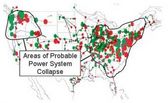
What
if the May 1921 superstorm occurred today? A US map of vulnerable
transformers with areas of probable system collapse encircled.
Did you know a solar flare can make your toilet stop working?
That's the surprising conclusion of a NASA-funded study by the National Academy of Sciences entitled Severe Space Weather Events - Understanding Societal and Economic Impacts.
In the 132-page report, experts detailed what might happen to our
modern, high-tech society in the event of a "super solar flare"
followed by an extreme geomagnetic storm. They found that almost
nothing is immune from space weather - not even the water in your
bathroom.
The problem begins with the electric power grid. "Electric
power is modern society's cornerstone technology on which virtually all
other infrastructures and services depend," the report notes. Yet it is
particularly vulnerable to bad space weather. Ground currents induced
during geomagnetic storms can actually melt the copper windings of
transformers at the heart of many power distribution systems. Sprawling
power lines act like antennas, picking up the currents and spreading
the problem over a wide area. The most famous geomagnetic power outage
happened during a space storm in March 1989 when six million people in
Quebec lost power for 9 hours (see image below).
According
to the report, power grids may be more vulnerable than ever. The
problem is interconnectedness. In recent years, utilities have joined
grids together to allow long-distance transmission of low-cost power to
areas of sudden demand. On a hot summer day in California, for
instance, people in Los Angeles might be running their air conditioners
on power routed from Oregon. It makes economic sense - but not
necessarily geomagnetic sense. Interconnectedness makes the system susceptible to wide-ranging "cascade failures."
To estimate the scale of such a failure, report co-author John
Kappenmann of the Metatech Corporation looked at the great geomagnetic
storm of May 1921, which produced ground currents as much as ten times
stronger than the 1989 Quebec storm, and modeled its effect on the
modern power grid. He found more than 350 transformers at risk of
permanent damage and 130 million people without power. The loss of
electricity would ripple across the social infrastructure with "water
distribution affected within several hours; perishable foods and
medications lost in 12-24 hours; loss of heating/air conditioning,
sewage disposal, phone service, fuel re-supply and so on."
"The concept of interdependency," the report notes, "is
evident in the unavailability of water due to long-term outage of
electric power--and the inability to restart an electric generator
without water on site."
The strongest geomagnetic storm on record is the Carrington
Event of August-September 1859, named after British astronomer Richard
Carrington who witnessed the instigating solar flare with his unaided
eye while he was projecting an image of the sun on a white screen.
Geomagnetic activity triggered by the explosion electrified telegraph
lines, shocking technicians and setting their telegraph papers on fire;
Northern Lights spread as far south as Cuba and Hawaii; auroras over
the Rocky Mountains were so bright, the glow woke campers who began
preparing breakfast because they thought it was morning. Best estimates
rank the Carrington Event as 50% or more stronger than the superstorm
of May 1921.

A web of interdependencies makes the modern economy especially sensitive to solar storms.
"A
contemporary repetition of the Carrington Event would cause ...
extensive social and economic disruptions," the report warns. Power
outages would be accompanied by radio blackouts and satellite
malfunctions; telecommunications, GPS navigation, banking and finance,
and transportation would all be affected. Some problems would correct
themselves with the fading of the storm: radio and GPS transmissions
could come back online fairly quickly. Other problems would be lasting:
a burnt-out multi-ton transformer, for instance, can take weeks or
months to repair. The total economic impact in the first year alone
could reach $2 trillion, some 20 times greater than the costs of a
Hurricane Katrina or, to use a timelier example, a few TARPs.
What's the solution? The report ends with a call for
infrastructure designed to better withstand geomagnetic disturbances,
improved GPS codes and frequencies, and improvements in space weather
forecasting. Reliable forecasting is key. If utility and satellite
operators know a storm is coming, they can take measures to reduce
damage - e.g., disconnecting wires, shielding vulnerable electronics,
powering down critical hardware. A few hours without power is better
than a few weeks.
NASA has deployed a fleet of spacecraft to study the sun and
its eruptions. The Solar and Heliospheric Observatory (SOHO), the twin
STEREO probes, ACE, Wind and others are on duty 24/7. NASA physicists
use data from these missions to understand the underlying physics of
flares and geomagnetic storms; personnel at NOAA's Space Weather
Prediction Center use the findings, in turn, to hone their forecasts.
At the moment, no one knows when the next super solar storm
will erupt. It could be 100 years away or just 100 days. It's something
to think about the next time you flush.
Dr. Tony Phillips, Science@NASA
Comment: The
concept of interdependency goes way beyond how long power is down in
Canada because the sun sneezed the day before. While it's encouraging
to see the connection being made between solar storms and interruption
to electricity networks, sadly the wider issue of cosmic interference
in Earth's systems is ignored despite the alarming reports of fireballs
and meteorites piercing the planet's lower atmosphere.
The effects from a cometary impact would cause substantially
greater damage to our fragile systems, producing catastrophic "cascade
failures" on an ecological and humanitarian scale. It's now fairly well
established that this has happened several times within humanity's lifespan:
[...] the Holocene Impact Working Group - named for the period covering
the last 20,000 years - have been proposing for years that several large objects from space hit the Earth with enough force to influence global climate within human history. Abbott estimates this happened perhaps five times in the last 6,000 years.
The increasing awareness that Earth meets cosmic storms on a regular basis is injecting some urgency into the issue:
UN is told that Earth needs an asteroid shield
US urged to prepare for asteroid strike
Asteroid and comet threat is a challenge to mankind
...but the signal is being drowned out by the noise generated by the twin hoaxes of the Global Pathocracy; Global Warming and the War on Terror.
Scientists note that incoming objects can produce very loud sounds, like the earth-shattering thunder that accompanied the Tunguska cometary explosion. Could the tremendous booms people are hearing be overhead explosions as space debris meets the atmosphere?
A recent chronology, by no means conclusive, of mysterious 'sonic' booms:
Feb 7th, Gold Coast, Australia
Feb 5th, Marco Island, Florida, USA
Jan 21st, Grand Island, Nebraska, USA
Jan 15th, North Carolina, USA
10th Jan, Louisiana, USA
5th Jan, Calgary, Canada
2nd Jan, Alaska, USA
30th Dec, South Carolina, USA
24th Dec, Iowa, USA
12th Nov, Indiana, USA
11th Nov, Arkansas, USA
5th Nov, New Zealand
Note how many are occurring / reported in the USA. Perhaps the Universe is trying to tell us something?
Bright lights that suddenly streak across the night sky with an
accompanying boom tend to elicit a flurry of phone calls to local
police departments.
These rare events aren't typically wayward missiles, or
satellite debris (as was thought when one such streak recently lit up
the skies over Texas), or alien invasions. But they do come from outer
space.
Scientists aptly call the objects fireballs because they are the brightest meteors, or "shooting stars," that fall to Earth.
A fireball as bright as the full moon raced across the Spanish
skies on July 11, 2008, and was tracked by the Spanish Fireball Network
(SPMN). Researchers used the tracking data to trace the path of the
comet backwards through the sky and space; they think the boulder may
be a chunk of a comet that broke up nearly 90 years ago. Their
conclusions are detailed in the Feb. 11 online issue of the journal Monthly Notices of the Royal Astronomical Society.
It's possible that chunks of the fireball made it to the ground and are
waiting to be picked up, the researchers said, which would give
scientists a rare glimpse into the heart of a comet.
Meteors and fireballs
Earth and the other planets of the solar system are under
constant bombardment from particles that range in size from a sand
grain to a boulder and are collectively known as meteoroids. Many
meteoroids are the detritus left over from collisions of asteroids and
comets and impacts to other planets.
If a meteoroid enters Earth's atmosphere, it starts to burn
up, forming a bright streak in the sky, called a meteor. Meteors can
come from asteroid or comet fragments. If that meteor is brighter than
any of the planets in the sky, it is deemed a fireball (also called a
bolide).
A blazing bolide can also create a sonic boom that can be
heard up to 30 miles away - these explosive noises were heard over
Kentucky on Friday, Feb. 13, and over Texas on Sunday, Feb. 15, causing
a number of startled citizens to call local law enforcement.
Initial speculation that these streaks of light and accompanying boom
were caused by debris from the Feb. 10 collision of two satellites was
later refuted by astronomers, who said it was likely a meteor. Preston
Starr, the observatory manager at the University of North Texas, told
the Associated Press that the object would have been about the size of
a truck and that somewhere between eight and 10 such objects burn up in
the atmosphere every year.
Spanish sighting
The bolide that shot across the Spanish skies in July was also seen in Portugal and southern France.
At maximum intensity, it was 150 times brighter than the full
moon. It was first picked up by the SPMN above Bejar in the western
part of Spain at a height of about 61 miles (98 kilometers) and
disappeared from view at about 13 miles (21 kilometers) above the
surface of the Earth.
A professional photographer also snapped a picture of the streak from the north of Madrid.
From these images, astronomers Josep Trigo-Rodríguez of the
Institute of Space Studies, CSIC-IEEC in Spain, Jose Madiedo of the
University of Huelva-CIECEM in Spain and Iwan Williams of the
University of London were able to deduce the trajectory and properties
of the incoming fireball.
Their work was funded by the Spanish Ministry of Science and
Innovation, the National Institute of Aerospatial Technique, and the
Junta de Andalucía.
The team thinks the bolide was a dense object, about 3 feet
(about 1 meter) across with a mass of about 4,000 pounds (1.8 tonnes).
This would be like squeezing an adult elephant down to the size of an
armchair.
The rock would have been big enough that chunks of it may have
survived the fiery passage through the atmosphere and hit the ground as
meteorites. Finding these pieces would be a boon to science if they
are, as the team suspects, remnants of a comet breakup.
The bolide traveled an unusual orbit around the sun, as
determined by the astronomers, following a path that took it from
beyond the orbit of Jupiter to the vicinity of Earth. This orbit is
similar to that of a cloud of dust particles known as the Omicron
Draconids, which on rare occasions produce a minor meteor shower on
Earth.
This collection of meteoroids is thought to originate from the breakup of Comet C/1919 Q2 Metcalf in 1920.
It has been proposed that comets consist of large boulders
glued together by a mixture of smaller particles and ice. If the
nucleus of the comet disintegrates, the boulders are set loose in
space. Finding chunks of the Bejar bolide could help confirm this
theory.
"Handling pieces of comet would fulfill the long-held
ambitions of scientists - it would effectively give us a look inside
some of the most enigmatic objects in the solar system,"
Trigo-Rodríguez said.
Video - All About Comets
Video - Comets: Bright Tails, Black Hearts
Video - The Comet That Changed Comet-Hunting
Planet Earth Online
Mon, 23 Feb 2009 10:00 UTC
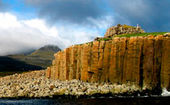
The remnants of a large volcanic eruption in the Faroe Islands. These eruptions can go on for millions of years.
Scientists have long debated the cause of the dinosaurs' extinction about 65 million years ago.
Around this time a giant meteorite struck the Gulf of Mexico. But the
extinction also seems to coincide with massive and long-lasting
volcanic eruptions in India known as the Deccan Traps. So which event
was responsible? And are these phenomena linked?
New research now shows that this combination of meteorite
impact and large-scale volcanic activity - known as flood basalt
eruptions - is not unique.
An international team of researchers looked at a
30-million-year-old meteorite crater in Belarus called Logoisk. They
found that this too coincided with volcanic eruptions further south
which covered Yemen and Ethiopia with basalt rock.
These events are similar to those that occurred 65
million years ago, but on a much smaller scale. The scientists suggest
such coincidences maybe more common than previously thought.
Dr Sarah Sherlock from the Open University and lead author of
the paper, says, 'If you have a flood basalt then people wonder if
there's also an impact.'
'There will be, almost certainly,' she added.
According to the paper, a meteorite will strike the Earth and
leave a crater the size of Logoisk on average once every 1.5 million
years. Flood volcanic eruptions occur over several million years, so a
Logoisk-sized crater is likely to occur during each of the 16
identified periods of flood volcanism on Earth in the last 360 million
years.
However, researchers do not think there is a causal link between flood volcanism and meteorite impact.
'There is simply no geological evidence to link the two,' says Sherlock.
To determine the precise age of the Logoisk crater the
researchers used argon dating. 'Argon dating is very versatile.' said
Sherlock. 'It's the only technique that can be used to date both
[impacts and flood volcanism].'
Samples of material from the crater were gradually heated
using an infrared laser, causing the release of argon gas. The ratio of
two isotopes of argon released in the gas gives an accurate indication
of the age of the sample. Using this technique, the researchers showed
that the two events occurred simultaneously.
One question raised by the results was why the meteorite
impact and flood volcanism 65 million years ago wiped out much of life
on Earth, including the dinosaurs, but the similar events 30 million
years ago did not. According to Sherlock, it was down to the size of
the events.
'These coincidences in Earth's history are not as rare as
people think, but in order to actually do significant damage to the
environment they have to be really, really big.' Sherlock added.
Together, the 65-million-year-old Chicxulub crater in the Gulf
of Mexico and volcanic eruptions that produced the Deccan Traps
eruption 65 million years ago released 8000 gigatonnes (Gt) of sulfur
dioxide, causing global environmental damage. By comparison the Logoisk
and Afro-Arabian events released only 30Gt - insufficient to cause
change on a global scale.
The research is published in the Journal of the Geological Society, London.
News8Austin
Mon, 23 Feb 2009 16:37 UTC
Veronica Castelo
It's
hard to forget the image of a fireball in the sky caught on tape in
broad daylight during last Sunday's Austin Marathon. Speculation ended
as to what the fireball really was when experts determined that it was
a meteor.
Now there's actual physical proof that it was a meteor.
Amateur astronomer Doug Dawn and his team say they were able to find
meteorites. Dawn's team analyzed the video footage shot by News 8
photographer Eddie Garcia. Dawn said there was a lot of information
available in the film and it helped with calculations of where the
material was coming from.
Rob Matson is an expert in Los Angeles who helped narrow the likely
location of the meteorite's landfall. Dawn and his team already had
radar data and immediately made their way out to the countryside in the
Waco area.
Rob Matson is an expert in Los Angeles who helped
narrow the likely location of the meteorite's landfall. Dawn and his
team already had radar data and immediately made their way out to the
countryside in the Waco area.
The main mass was not found. With the help of area residents
who reported observing the fall, the team immediately recognized and
collected multiple tiny blackened, fusion crusted meteorite fragments.
"The Texas sized hospitality, tolerance, and enthusiastic
cooperation of the landowners was greatly appreciated by the search
team," Dawn said.
Two days after the fall, the team sent their findings to Los
Angeles to Alan Rubin, Ph.D. at UCLA, a meteorite classification
scientist. Classification is very important because until an approved,
official meteoritical scientist approves a meteorite, it's not
official. Chemical analysis was conducted on the meteorite to further
confirm its identification.
Rubin said fresh meteorites have distinct characteristics,
such as being all black, as long as it's not cracked. Once it's
cracked, the inside is typically a light, gray metal flex, called the
matrix. Dr. Rubin determined that it was an ordinary chondrite, also
known as a Type L6.
L6's are one of the most common types of meteorites that fall,
and possibly are originally from asteroid (8)Flora, a large asteroid
whose orbit lies between Mars and Jupiter's, though scientists are
still working out the details of origin.
"The entire experience was as incredibly exciting as it was
incredibly humbling, to think, that hours earlier these meteorites were
part of a tiny asteroid, called a meteoroid, floating in the heavens,"
Dawn said. "This is the stuff that dreams are made of, for an amateur
astronomer, to actually reach out and touch a piece of heaven that we
admire so much in our telescopes, and to contribute importantly to
science by recovering it and providing it for analysis. It shows us our
small place in the universe."
A suspicious orange light flying over a Long Ditton home stirred the interest of UFO investigators this week.
The strange sighting was made by Debbie Leigh, 48, and her husband on
Saturday, February 21, as she smoked a cigarette in her garden in Oaks
Way, south west London.
No strangers to disturbance from planes flying over to
Heathrow, they originally thought the object might be a burning
aircraft.
But as it passed over their house at a consistent height and speed for
several minutes, they were left baffled and recorded it on an online
UFO sightings log in the hope that others had seen it too.
It had been an ordinary evening for the Leigh family.
Her husband Mark was preparing a Sunday lunch and Mrs Leigh was working
on the computer before they made their discovery shortly after 7pm.
The mother of two, who works in music PR, insists that she was not drunk at the time and had never seen a suspected UFO before.
She said: "The weirdest thing is that it didn't make a sound,
which is why we thought it might be something peculiar. My husband is a
bit of a UFO geek and when he came out and saw it he got goose bumps.
"I think it would be extremely arrogant of us to think that we
are the only people in the universe. I wouldn't be surprised if there
was alien life, I don't know about little green men and all that
rubbish but if we can work it out, why can't anyone else?"
Investigator David Willey, of the North Surrey Paranormal
Group, said it was the first credible sighting he has come across this
year.
But he suggested that the orange light could have been a
shooting star without a tail or a piece of space debris that burnt up
in the atmosphere.
He added: "If it shot off really quickly or if it shot up vertically, then I would be really suspicious."
Multiple people in Waukesha County called WTMJ reporters and the
Waukesha Sheriff's Department, reporting unusual lights in the evening
sky.
Could it have been something from another world, a UFO?
"Somebody saw something," said Waukesha County Sheriff's Captain Karen Ruff.
"I don't know if it was just a planet, the sky, the clouds, the stars or what it was. There was something out there.
"We do let our officers know, because it could be a plane or a
helicopter in trouble. We do have them go out and look. Nobody saw
anything, so we don't quite know what it was."
Well, some astronomers think they identified it as the comet Lulin, making a one-time journey near Earth.
Those of us that don't follow astronomy, however, wondered just what in X-Files was going on.
"The first call we got was from a woman from the Town of Ottawa," said Ruff.
"She called in at about 6:30 p.m., and she said she saw a red and blue
light in the sky. It wasn't moving. She thought it could be a
satellite, but just thought that she should just call it in and let us
know what was going on.
"We got a second call a little after that, probably about a
little after 7:15 p.m. A lady in Waukesha called and said that she saw
it to the west, that it was standing still in the sky, numerous lights,
appearing to be too large to be a planet. It wasn't moving. She didn't
think it was an airplane or a helicopter.
That second call corresponded to what one caller told us.
"I looked in the sky and saw this bright light," said the caller.
"It was changing colors, so I knew it was not a star. It
actually started changing shapes and stayed stationary. It was not an
airplane, and it was not a helicopter.
"It had red and gold, it had blue and green. I don't know what
the heck it is. I did see color changes. You did see red at the bottom.
Then there would be a red spot at the top, then there would be a blue
light at the left, and almost like a tail that gave shape to it."
Another caller into WTMJ gave us this description.
"I saw this white light above the horizon in the city of
Waukesha, and it had green and red lights circulating around it," said
the caller.
"It was moving. It was really low to the ground, and it was
moving slow. It didn't look like a helicopter, and it wasn't making any
noise.
"We saw two of the exact same thing, at the same height,
looking the same colors, and the one went towards the other one and
disappeared. We were watching it and, all of a sudden, couldn't see it
anymore.
"When I was standing on my back porch, it looked like it had an aura around it."
That's because comets typically do have auras as they travel.
The Chicago Tribune reported that the comet was as close as 38
million miles away from Earth, and that close approach to Earth caused
the light show.
RIA Novosti
Wed, 25 Feb 2009 10:04 UTC
Andrei Kislyakov
Humankind
has created a major problem: space debris, now threatening long-term
space travel. So much space junk has accumulated that the international
community must take urgent action to prevent major accidents at high
altitude and on Earth.
Space debris denote man-made objects in orbit around Earth
that no longer serve any useful purpose but which endanger operational
satellites, primarily manned spacecraft. In some cases, space junk may
threaten Earth during reentry because some fragments do not burn up
completely and can hit houses, industrial facilities and transport
networks.
Right now, 40 million fragments of space debris weighing
several thousand metric tons circle Earth. In mid-February, the United
Nations Office for Outer Space Affairs (UNOOSA) reaffirmed the
importance of guiding principles to prevent the formation of space
debris for all nations.
On December 17, 2007, the UN General Assembly passed its
Resolution 62/101 stipulating recommendations on enhancing the practice
of states and international intergovernmental organizations in
registering space objects.
Concerted international efforts and the dangers of
hypothetical space debris crashes will make it possible for humankind
to cope with this problem in the long term. However, Earth is still
threatened by asteroids and various comets.
Scientists are particularly concerned about the potentially
hazardous asteroid 99942 Apophis, which will fly close to Earth in
2029. Russian astronomer Sergei Smirnov said the asteroid with a
diameter of 600 meters spelled nothing good for geostationary
telecommunications platforms, due to be launched by that time.
In 2012, Apophis will pass close enough to Earth, enabling scientists to more accurately calculate its 2029 orbit.
Astronomers estimate that at least one out of the 100,000 small
planets or asteroids, discovered since 1801, annually approaches Earth.
Moreover, U.S. scientists have recently solved a discrepancy which may
spell extremely negative consequences for our civilization.
It is common knowledge that a new comet annually enters the solar system. Judging by the average lifespan of comets, about 3,000 of them fly through the solar system each year. In reality, astronomers register only 25 comets.
Scientists seem to have solved this contradiction. This
discrepancy between theoretical calculations and practical observations
is explained by the fact that many comets cannot be detected by optical systems.
It appears that such objects are created when a celestial body's
nucleus loses most of its water due to evaporation. This makes new
comets too dark to be observed through optical telescopes and a
potential threat to planet Earth.
The latest studies of terrestrial and lunar craters show that
most of them were gouged by comets. This news is not very encouraging
either.
Rachel Courtland
New Scientist
Wed, 25 Feb 2009 21:23 UTC

The
distribution of rocks in the asteroid belt has retained traces of the
migration of the giant planets billions of years ago, a new simulation
suggests.
Today's asteroid belt may have been shaped by a tumultuous period
in the early solar system when Jupiter and Saturn moved out of their
original orbits, a new simulation suggests. Ultimately the work could
help refine a picture of how quickly the planets moved and where they
got their start.
Recent studies have suggested that many objects in the solar
system were reshuffled nearly 4 billion years ago. Jupiter, Saturn,
Uranus, and Neptune, are thought to have been born close together
before gravitational interactions with numerous pieces of rocky debris
changed their trajectories.
Their movement then caused the rocky debris to scatter like
bowling pins, potentially explaining what battered the Earth, Moon, and
Mars with so many craters some 3.8 billion years ago.
Now, this same reshuffling might explain the appearance of the main asteroid belt between Mars and Jupiter.
Several grooves in the belt seem to be empty of asteroids. Called
Kirkwood gaps, they are thought to be cleared of debris by Jupiter's
gravity, which causes any objects orbiting there to move chaotically.
Saturn's moons have produced similar gaps in the planet's rings.
David Minton and Renu Malhotra at the University of Arizona in
Tucson wanted to reproduce the asteroid belt and its gaps in a computer
simulation.
Shifting position
Using the current orbits of the giant planets Jupiter, Saturn,
Uranus, and Neptune, the team was able to roughly replicate the
observed distribution of asteroids over a simulated period of some 4
billion years.
But they had much better luck when they started out with the
best estimates of where the giant planets were early in the solar
system's history. The four planets are thought to have started out
relatively close together. Then, Jupiter moved inward while Saturn,
Uranus and Neptune moved outward.
"We're able to produce an asteroid belt that's much more like
the observed asteroid belt than a model that only uses the giant
planets in their current positions," Minton says.
Eroding belt
In this version of the simulation, two of the belt's gaps
showed a distinct signature: a sharp inner edge and a smeared out,
relatively empty outer edge.
That is what would be expected if Jupiter carved the gaps as
it migrated towards the Sun. In that case, the gaps' inner edges
represent where Jupiter stopped in its migration, says Minton. Such a
gap "profile" is a closer match to the observed asteroid distribution
than the team's other simulation using the planets' current orbits, he
adds.
Saturn's outward migration also seems to have left its imprint
on the asteroid belt. But in Saturn's case, it was on the inner edge of
the entire belt - not the gaps. At the belt's inner edge, asteroids
were lost because their orbits were destabilised by the natural wobble
of Saturn's orbit over time. This erosion continued as Saturn moved
outward, so that the inner edge of the belt is determined by the Ringed
Planet's current orbit.
Migration speed
In the simulation, the belt lost 62% of its original population
of asteroids due to the migration of the giant planets. But some
estimate that the real asteroid belt actually lost some 90 to 95% of
its asteroids.
The slower the planets' migration, the more asteroids will be
lost due to gravitational interactions with them. "If the planets were
migrating too slowly, you wouldn't have an asteroid belt," Minton told New Scientist.
By refining the model, astronomers could get a better sense of how long
the migration took and where the planets got their start, he adds.
And if cast-out asteroids are responsible for the Late Heavy
Bombardment that pounded the Earth, Moon, and Mars 3.8 billion years
ago, modelling the belt could also help determine how long the outburst
might have lasted.
Journal reference: Nature (vol 457, p 1109)
Helensburgh Advertiser
Wed, 25 Feb 2009 19:13 UTC
Fiona Howard
A Helensburgh man, washing his dishes on Monday, looked out of his kitchen window and thought he saw a plane about to crash.
But now he is looking to hear from anyone else who saw the strange phenomenon which he now believes was a UFO.
Lewis Graham, a graphic artist, was working at the sink in his Lomond
Street flat just before seven o'clock when he saw the fiery red object
pass across the window.
He said: "At first I thought it was a plane on fire or a helicopter. Then I thought it was an asteroid descending!
"It was silent and appeared to have a single red light to the rear. It
must have been really low as there was nearly 100 per cent cloud cover.
"It remained stationery over what I reckon was Cardross then got dimmer and vanished.
"I've never seen anything like it and at one point I panicked
and thought about taking cover as I thought it was going to plummet
down to earth!"
He added: "I noticed other people stopping in the street to look and some even stopped their cars and got out.
"It seemed to come from the Faslane direction and went straight
across towards Cardross before it stopped and then gradually faded
away.
"It must have been very low because there was a lot of cloud and no stars.
"It was just really weird, really strange."
Lewis took a moment to switch everything off in his house so that he could hear any noise it made but it was completely silent.
He went on: "I am a keen amateur astronomer and I know my stars
and planets but until now I have always been an unbeliever when it
comes to UFOs but now I believe."
Lewis reported his sighting to the UK UFO Sightings website
and found that a very similar sighting had been reported on January 19
over Partick as well as others in England.
Did YOU see this object? Email us at editorial@helensburghadvertiser.co.uk or call 01436 673434
A six-pound chunk of charred metal blasted through the roof of a house in Southeast Oak Cliff Tuesday evening.
The object crashed through the second floor of the home in the 7800
block of Buford Drive before coming to rest in the kitchen on the
ground floor.
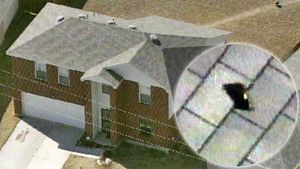
Inset
shows a close-up of the hole in the roof of a house on Buford Drive
where an unidentified object crashed through on Tuesday evening.
No one was home at the time of the incident and there were no injuries.
The Dallas Fire-Rescue biohazard unit checked the unidentified flying object for radiation and found none.
Police say they have no idea what the metal is or where it came from. State and regional officials have been notified.
Investigators say they are not aware of any other reports of similar activity in the area.
Two large man-made satellites collided in orbit over Siberia on
February 10, and military officials have been on alert since then for
possible falling debris.
A large meteor fell to earth near Waco on February 15, and the
fireball could be seen over a wide area of North and Central Texas.
The Inquirer and Mirror
Fri, 27 Feb 2009 10:59 UTC
Eliot Baker
Island residents are being urged by Maria Mitchell Association director
of astronomy Vladimir Strelnitski to keep their eyes open for
meteorites around Surfside and the south shore in the coming days
following an unconfirmed sighting of a fireball blazing across the
early-morning sky Friday, Feb. 20 at 4:30 a.m.
Terry Galschneider was up early watching television when she
said a dramatic orange fireball "lit up the sky" for five seconds. She
said the fireball was too large and bright to have been a shooting star
or a helicopter. Her full description to Strelnitski left him to "not
exclude that it fell in the ocean, but maybe even on land."
The object's brightness suggests it would be relatively close
to Galschneider, although its lack of sound made that even less
possible to tell for certain. He said it was highly unlikely to have
been debris from colliding satellites.
The sighting was not confirmed by either Nantucket
airport officials or by the police, and no other reports of fiery
objects in the sky Friday in Massachusetts have been made to NASA, or
to astronomy departments at Boston University, the University
Massachusetts at Lowell, or the American Meteor Society.
Other islanders who may have spotted the fireball are encouraged to
contact Strelnitski at the Maria Mitchell Association at (508)
228-5273.
Though unlikely, Strelnitski said discovering a meteorite - or
part of one - on Nantucket would be unprecedented and could yield
important information to scientists. People around Surfside especially
are encouraged to look for unusual small craters with valleys on the
surface with strange objects inside.
Meteors can be a piece of metal, a greenish or grayish piece of stone,
or a black piece of organic matter that resembles coal called carbonatious condrite, the rarest of all meteorites.
Two pieces from a meteor that blazed across the Texas sky this month are going from the asteroid belt to the auction block.
Dallas-based Heritage Auction Galleries announced Thursday that it is
putting two meteorites up for sale May 17. One is an 8-ounce specimen
that could fetch up to $5,000.
The meteorites were discovered in the West area, about 70
miles south of Dallas, by an Arizona meteorite hunter whose trip was
partially financed by an anonymous collector in New York, said David
Herskowitz, natural history consultant for the auction house.
"Both specimens are extensively covered with fresh fusion crust from burning through the atmosphere," Herskowitz said.
People across Texas reported seeing a fireball Feb. 15. The Federal
Aviation Administration at first suggested that it could have been
debris from colliding satellites, but later said it was probably a
natural phenomenon.
A pair of University of North Texas astronomers also
discovered two meteorites near West, saying they were about the "size
of large pecans."
The pieces are chondrite, which is "a pretty common type of
space rock," said Ron DiIulio, the director of the astronomy laboratory
program at UNT. He and another UNT astronomer have already run one of
the rocks through a series of tests.
"We are tracking down the possibility that they are part of a
large asteroid collision that was over 100 kilometers in size," DiIulio
said. "They are from the asteroid belt. It appears two huge ones
crashed, because this one shows evidence of a catastrophic collision
that knocked it into the path of our atmosphere."
The UNT professors are not selling their rocks, but said they will instead study them and put them on display at the university.
Lori Stiles
The University of Arizona
Wed, 25 Feb 2009 01:22 UTC
University of Arizona scientists have uncovered a curious case of missing asteroids.
The main asteroid belt is a zone containing millions of rocky objects
between the orbits of Mars and Jupiter. The scientists find that there
ought to be more asteroids there than researchers observe. The missing
asteroids may be evidence of an event that took place about 4 billion
years ago, when the solar system's giant planets migrated to their
present locations.
UA planetary sciences graduate student David A. Minton and UA
planetary sciences professor Renu Malhotra say missing asteroids is an
important piece of evidence to support an idea that the early solar
system underwent a violent episode of giant planet migration that might
possibly be responsible for a heavy asteroidal bombardment of the inner
planets.
The scientists are reporting on their research in an
article, "A record of planet migration in the Main Asteroid Belt," in
the Feb. 26 issue of Nature.
Minton and Malhotra began by looking at the distribution of asteroids
in the main asteroid belt. Astronomers first discovered a series of
gaps in the asteroid belt, now called the Kirkwood gaps, back in the
1860s when only a handful of asteroids were known. The gaps occur at
distinct regions of the asteroid belt where Jupiter's and Saturn's
gravity strongly perturbs and ejects asteroids. The present-day orbits
of Jupiter and Saturn explain why these unstable regions are devoid of
asteroids.
"What we wanted to know was, how much of the structure of the
asteroid belt could be explained simply by the gravitational effects of
the giant planets, as are the Kirkwood gaps," Minton said.
Minton and Malhotra looked at the distribution of all
asteroids with diameters greater than 50 kilometers, or about 30 miles.
All asteroids of this size have been found, giving the UA researchers
an observationally complete set for their study. Also, almost all
asteroids this large have remained intact since the asteroid belt
formed more than 4 billion years ago, a time record spanning all but
the very beginning of solar system history.
"We ran massive sets of simulations with computer planets
where we filled up the asteroid belt region with a uniform distribution
of computer asteroids," Minton said. The scientists then had the
computers simulate the billions of years of solar system history.
Their simulations ultimately ended with far more asteroids
remaining than are actually observed in the asteroid belt. When the
simulated asteroid belt was compared with the actual asteroid belt,
they discovered a peculiar pattern in the differences. The simulated
asteroid belt matched the real asteroid belt quite well on the
sunward-facing sides of the Kirkwood gaps, but the real asteroid belt
seemed to be depleted in asteroids on the Jupiter-facing sides.
"Then we simulated the migration of the giant planets," Minton
said. "The perturbing effects of the migrating planets sculpted our
simulated asteroid belt. After the migration was over, our simulated
asteroid belt looked much more like the observed asteroid belt."
The UA scientists' research was funded by NASA and by the National Science Foundation.
"Our interpretation is that as Jupiter and Saturn migrated,
their orbital resonances swept through the asteroid belt, ejecting many
more asteroids than is possible with the planets in their current
orbits," Malhotra said. "And the particular pattern of missing
asteroids is characteristic of the pattern of Jupiter's and Saturn's
migration."
"Our work explains why there are fewer asteroids on the
Jupiter-facing side of the Kirkwood gaps compared to the sun-facing
side," Minton said. "The patterns of depletion are like the footprints
of wandering giant planets preserved in the asteroid belt."
Their results corroborate other lines of evidence indicating
that the giant planets - Jupiter, Saturn, Uranus and Neptune - formed
in a more tightly compacted configuration, and then Jupiter moved
slightly closer to the sun, while the other giant planets moved farther
apart from each other and farther away from the sun.
Minton and Malhotra say that their result has implications for
how far and how fast the planets migrated early in solar system
history, and the possibility that planet migration perturbed asteroids
that may have contributed to a heavy bombardment of the inner solar
system.
"Our result doesn't directly answer the question of whether
the timing of this can be tied to inner solar system heavy bombardment
- that's open for debate," Minton said. "But what it does say is that
there was an event that destabilized asteroids over a relatively short
period of time.
"All the asteroids being kicked out of the asteroid belt had
to go somewhere," he added. "The implication of this is that when all
those asteroids were getting kicked out of the main belt, they could
have become projectiles impacting the Earth and the moon, Mars, Venus
and Mercury."
Stan Gordon
Stan Gordon's UFO Anomalies Zone
Tue, 28 Oct 2008 17:42 UTC
Between 8 and 8:30 p.m. on the night of October 26, 2008, residents in
Westmoreland County, southeast of Pittsburgh, reported observing an odd
brilliant light show in the sky, which some observers felt was not
related to thunderstorm activity. I also have received observation
reports from as far away as Somerset County in Pennsylvania, and into
Ohio.
The first reports I received were from the Mount Pleasant
Township area. Later reports came in from various other areas of
Westmoreland County, including North Huntingdon Township, Greensburg
and Latrobe.
The initial reports from Mount Pleasant Township, described an
intense flash of white light which lit up the sky in all directions.
The flash lasted only a fraction of a second. Observers felt certain
that this was no lightning bolt. The exact position of where the flash
was originating from could not be determined since all sections of the
sky were illuminated.
The sky was very clear and full of stars. There was absolutely no thunder or other sound heard at the time.
About 45 seconds to a minute later, after the initial flash, another
brilliant flash lit up the sky just like the first. Then as though the
timing was synchronized, the same flashing effect occurred about two
more times, then suddenly ended. Once again, no sound of thunder.
It appeared to the observers that this was a very close event, and they would definitely have heard thunder.
One witness described the flash as, "a blinding light up." That
witness told me that she was so disturbed by what she saw, that her
first impression was that our country was under attack. She quickly
turned on the television to look for any breaking news reports.
In another report from Latrobe, a witness looking west,
described the flash as looking like a giant spotlight beam of light,
which was very bright. Other reports also indicated flashes to the west
of Greensburg.
The National Weather Service Office in Pittsburgh has
confirmed, that an arctic front was coming through western Pennsylvania
that evening between 8 and 9 p.m., and thunderstorm activity was being
reported. It is quite likely that some people did see lightning
associated with those storms. Some witnesses however, are convinced
that what they saw was not storm related, and they are seeking an
explanation for the sky phenomena which they observed.
Roger Marsh
UFO Examiner
Fri, 27 Feb 2009 17:55 UTC
Stories
of bright flashes of light in the sky continue to be reported from
around the country - today again from PA. Ufologist Stan Gordon got the
call and followed up with an investigation.
This report is similar to a Westmoreland County, PA, report Gordon reported on from Oct. 26, 2008, in Mysterious Sky Flashes Puzzle Pennsylvania Observers.
Stan Gordon's report follows:
Strange Light Flashes Over Chester County, Pennsylvania
On the night of February 24, 2009, two people walking a dog
near West Chester, PA, observed a light phenomena in the sky which they
are trying to find an explanation for. It was about 8:25 p.m. as the
couple was walking south in an area which was very dark, quiet, and had
no street lights, that their attention was drawn upward to the clear
star filled sky.
What they observed were five, or six very bright white flashes
of light which lit up the entire sky. While one flash seemed to be more
off in the distance, most of the flashes seemed to come from above and
illuminate the sky in all directions. One witness stated, "they were
like an extremely bright spotlight shining down on a very large area."
The exact location from where these flashes originated from was very
difficult to determine, since each burst was very quick, and did not
seem to originate from a specific direction, but just from overhead.
It was after the first bright flash that a sound unlike
thunder was heard. One of the observers described the sound as a
muffled, soft boom with each flash. The other said that it seemed like
a metallic thud, like in a tunnel, but not a metal on metal sound.
There were approximately 30 seconds to two minutes between each burst
of light.
Both observers were certain that what they saw was unlike any
lightning bolt or flashes of lightning that they had ever seen. Both
people have seen the Northern Lights, and one witness commented when
the flashes were first seen, that it looked similar, but did not have
any colors.
They also feel certain that it was not fireworks, or a power
transformer explosion, which both have seen. One witness did attempt to
call their local power company to find out if there had been any local
power transformer accidents in the area, but they were unable to obtain
any information.
I contacted the Philadelphia-Mount Holly, National Weather
Service forecast office, which services the Chester County area. I was
told that at the observation time, the sky was clear, there was little
wind, and temperature was in the 20's. There was no thunderstorm
activity in the area.
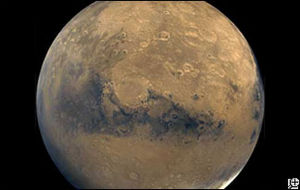
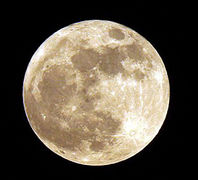
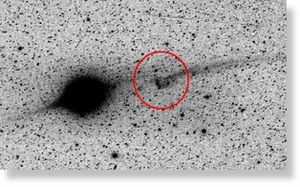

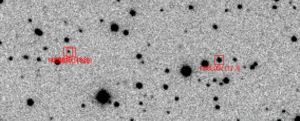
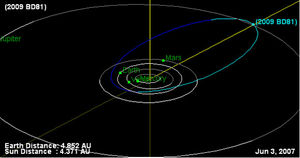
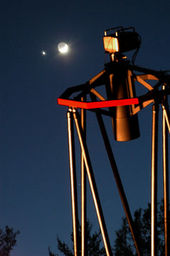
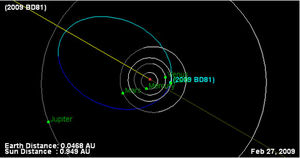
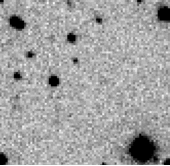
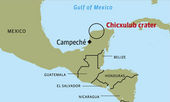
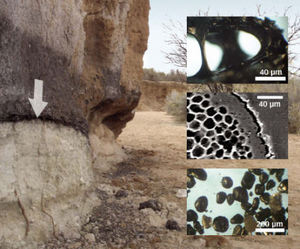
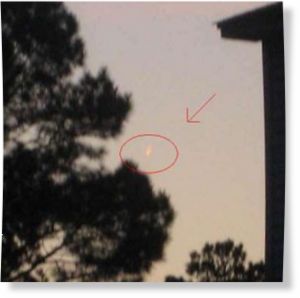
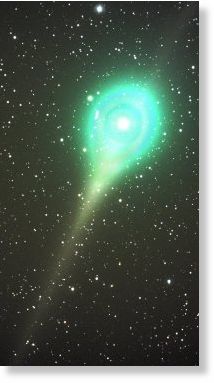
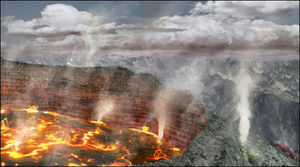
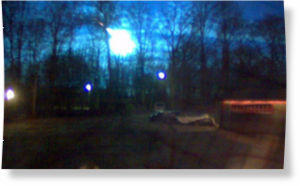
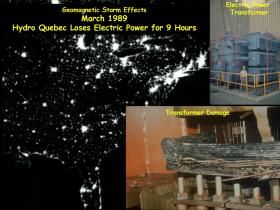
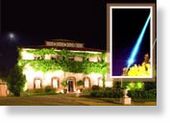
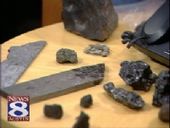

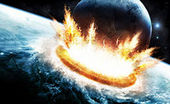
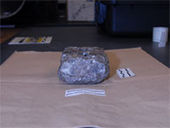
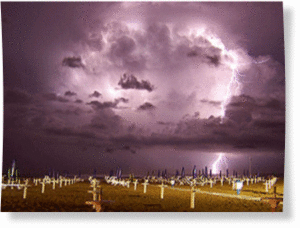
No comments:
Post a Comment